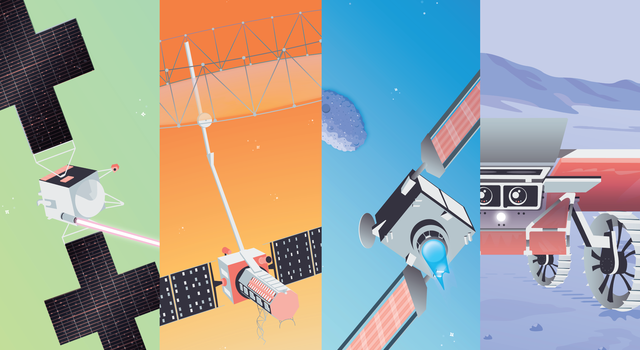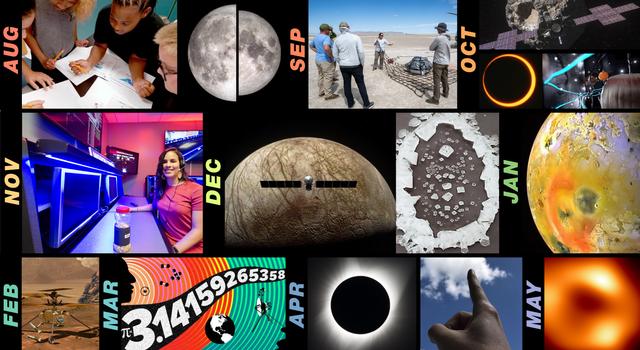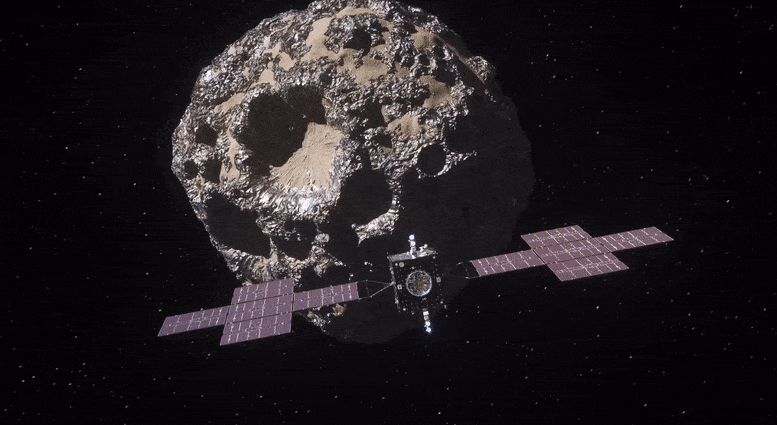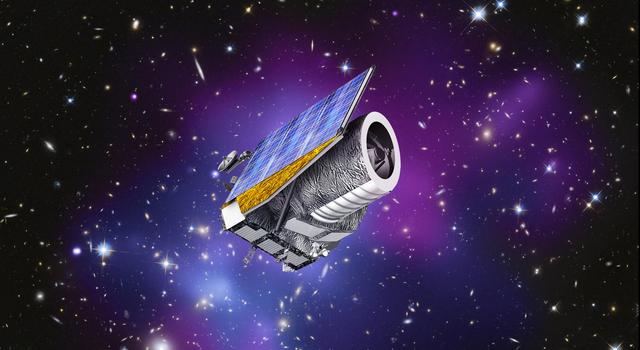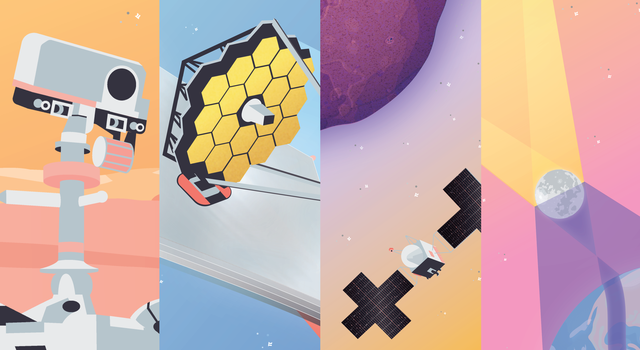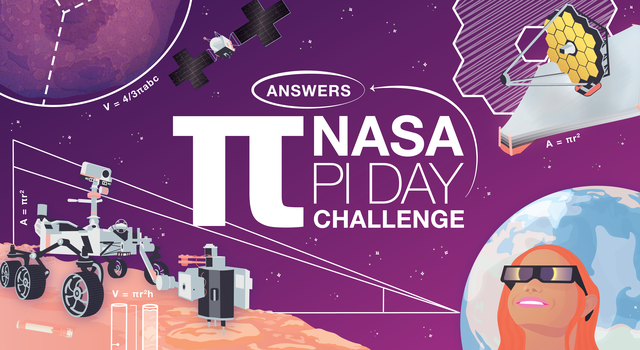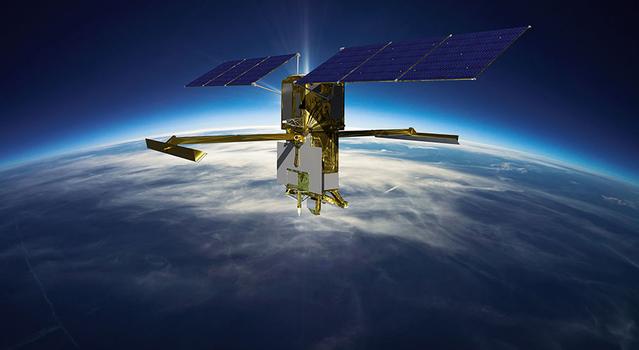Teachable Moments | March 18, 2024
The Science of Solar Eclipses and How to Watch With NASA
Get ready for the April 8 total solar eclipse. Learn about the science behind solar eclipses, how to watch safely, and how to engage students in NASA science.
On April 8, 2024, a total solar eclipse will be visible across much of the central and northeastern United States, as well as parts of Mexico and Canada.
Whether you are traveling to the path of the total eclipse or will be able to step outside and watch the eclipse where you live, here's everything you need to know, including what to expect, how to watch safely, and how to engage in scientific observations and discovery with NASA.
What Are Solar Eclipses?
Solar eclipses occur when the Sun, the Moon, and Earth align. For this alignment to happen, two things need to be true. First, the Moon needs to be in the new moon phase, which is when the Moon’s orbit brings it between Earth and the Sun. Second, eclipses can only happen during eclipse seasons, which last about 34 days and occur just shy of every six months. An eclipse season is the time period when the Sun, the Moon, and Earth can line up on the same plane as Earth's orbit during a new or full moon. If a new moon happens during an eclipse season, the shadow cast by the Moon will land on Earth, resulting in a solar eclipse. Most of the time, because the Moon’s orbit is slightly tilted, the Moon’s shadow falls above or below Earth, and we don't get a solar eclipse.
Not all solar eclipses look the same. The distance between the Sun, the Moon, and Earth plays an important role in what we see during a solar eclipse. Even though the Moon is much smaller than the Sun (about 400 times smaller in diameter), the Sun and Moon look about the same size from Earth. This is because the Sun is about 400 times farther away than the Moon. But as the Moon travels its elliptical orbit around Earth, its size appears slightly larger when it is closer to Earth and slightly smaller when it is farther from Earth. This contributes to the different kinds of solar eclipses you might have heard about. For example:
- During a total solar eclipse, the Moon is closer to Earth in its orbit and appears larger, completely blocking the Sun's disk. This allows viewers in the path of totality to see the Sun’s corona, which is usually obscured by the bright light of the Sun’s surface.
- An annular solar eclipse occurs when the Sun, Moon, and Earth are properly aligned, but the Moon is farther away in its orbit, so it does not completely cover the Sun's disk from our perspective. Annular eclipses are notable for the "ring of fire," a thin ring of the Sun’s disk that's still visible around the Moon during annularity. The name annular eclipse comes from the world of mathematics, where a ring shape is known as an annulus.
- Partial eclipses can happen for two reasons. First, viewers outside the path of totality during a total solar eclipse – or the path of annularity during an annular eclipse – will see only part of the Sun’s surface covered by the Moon. The other time a partial eclipse can occur is when the Moon is nearly above or below Earth in its orbit so only part of the Moon’s shadow falls on Earth. In this case, only part of the Sun’s surface will appear covered by the Moon.

This image of a total solar eclipse was captured on Aug. 21, 2017 from Madras, Oregon. Image credit: NASA/Aubrey Gemignani | › Full image and caption

On Jan. 4, 2017, the Hinode satellite captured these breathtaking images of an annular solar eclipse. Image credit: Hinode/XRT | › Full image and caption

The Sun appears partially eclipsed in this series of photos taken from NASA’s Johnson Space Center in Houston on Aug. 21, 2017. Image credit: NASA/Noah Moran | › Full image and caption
How to Watch the Upcoming Solar Eclipse
First, an important safety note: Do not look directly at the Sun or view any part of the partial solar eclipse without certified eclipse glasses or a solar filter. Read more below about when you can safely view the total solar eclipse without eclipse glasses or a solar filter. Visit the NASA Eclipse website for more information on safe eclipse viewing.
When following proper safety guidelines, witnessing an eclipse is an unparalleled experience. Many “eclipse chasers” have been known to travel the world to see solar eclipses. Here's what to expect on April 8, 2024:
The start time and visibility of the eclipse will depend on your location. You can use the interactive map below to find detailed eclipse information, including timing and coverage, by entering in your location. A list of some of the cities and start times along the path of totality is available on the NASA Science website.
Explore when and where to view the eclipse with this interactive map from NASA. Enter your zip code to see what will be visible in your viewing location and when to watch. Credit: NASA's Scientific Visualization Studio
The eclipse begins when the edge of the Moon first crosses in front of the disk of the Sun. This is called a partial eclipse and might look as if a bite has been taken out of the Sun.
It is important to keep your eclipse glasses on during all parts of the partial solar eclipse. The visible part of the Sun is tens of thousands of times brighter than what you see during totality. You can also use a pinhole camera to view the eclipse.
An approximately 115-mile-wide strip known as the path of totality is where the shadow of the Moon, or umbra, will fall on Earth. Inside this path, totality will be visible starting about 65 to 75 minutes after the eclipse begins.
If you are in the path of totality, it is safe to take off your eclipse glasses and look at the total eclipse only during totality. Be sure to put your glasses back on before the total phase ends and the surface of the Sun becomes visible again. Your viewing location during the eclipse will determine how long you can see the eclipse in totality. In the U.S., viewers can expect to see 3.5 to 5.5 minutes of totality.
After totality ends, a partial eclipse will continue for 60 to 80 minutes, ending when the edge of the Moon moves off of the disk of the Sun.
For more information about the start of the partial eclipse, the start and duration of totality, and the percentage of the Sun eclipsed outside the path of totality, find your location on this eclipse map.
On April 8, NASA Television will host a live broadcast featuring expert commentary and views from telescopes along the path of totality. Tune into the broadcast from 10 a.m. to 1 p.m. PDT (1 to 4 p.m. EDT) on the day of the eclipse.
Join NASA as a total solar eclipse moves across North America on April 8. Tune in from 10 a.m. to 1 p.m. PDT (1 to 4 p.m. EDT) for live views from across the path, expert commentary, live demos, and more. | Watch on YouTube
What Solar Eclipses Mean for Science
Solar eclipses provide a unique opportunity for scientists to study the Sun and Earth from land, air, and space, plus allow the public to engage in citizen science!

NASA’s Solar and Heliospheric Observatory, or SOHO, constantly observes the outer regions of the Sun’s corona using a coronagraph. Image credit: ESA/NASA/SOHO | + Expand image
Scientists measure incoming solar radiation, also known as insolation, to better understand Earth’s radiation budget – the energy emitted, reflected, and absorbed by our planet. Just as clouds block sunlight and reduce insolation, eclipses create a similar phenomenon, providing a great opportunity to study how increased cloud cover can impact weather and climate.
Solar eclipses can also help scientists study solar radiation in general and the structure of the Sun. On a typical day, the bright surface of the Sun, called the photosphere, is the only part of the Sun we can see. During a total solar eclipse, the photosphere is completely blocked by the Moon, leaving the outer atmosphere of the Sun (corona) and the thin lower atmosphere (chromosphere) visible. Studying these regions of the Sun’s atmosphere can help scientists understand solar radiation, why the corona is hotter than the photosphere, and the process by which the Sun sends a steady stream of material and radiation into space. Annular solar eclipses provide opportunities for scientists to practice their observation methods so that they'll be ready when a total solar eclipse comes around.
Citizen scientists can get involved in collecting data and participating in the scientific process during the eclipse through NASA’s GLOBE program. Anyone in the path of the eclipse and in partial eclipse areas can act as citizen scientists by measuring temperature and cloud cover data and report it using the GLOBE Observer app to help further the study of how eclipses affect Earth’s atmosphere.
Visit NASA's Eclipse Science page to learn more about the many ways scientists are using the eclipse to improve their understanding of Earth, the Moon, and the Sun.
Taking Eclipse Science Farther
Eclipses also make a great jumping-off point to concepts and techniques used in astrophysics and our search for planets beyond our solar system.
Similar to a solar eclipse, a transit occurs when a planet crosses in front of the face of a star. From Earth, the planets Venus and Mercury can occasionally be seen transiting in front of the Sun, appearing as small, dark dots. Transits are also useful for detecting exoplanets – distant planets around other stars. When an exoplanet passes in between its star and Earth, we can measure tiny dips in the star's brightness that tell scientists a planet is there even when it’s too small to see.
Another way that eclipse concepts are used for astrophysics is with coronagraphs, mechanisms inside telescopes that block the light from a star. By creating a sort of artificial eclipse, coronagraphs help scientists search for exoplanets by making much dimmer planets orbiting a star easier to see. For example, NASA’s Nancy Grace Roman Telescope, slated for launch later this decade, will use an advanced coronagraph to analyze and directly image planets that orbit other stars. Learn more about the astrophysics involved in eclipses, including the use of gravitational lensing to study background objects, from NASA’s Universe of Learning.
Learn how the coronagraph instrument on the Nancy Grace Roman Telescope will allow the spacecraft to peer at the universe through some of the most sophisticated sunglasses ever designed. | Watch on YouTube
Solar Eclipse Lessons and Projects
Use these standards-aligned lessons, plus related activities and resources, to get your students excited about the eclipse and the science that will be conducted during the eclipse.
-
 Student Project
Student ProjectHow to Make a Pinhole Camera
Learn how to make your very own pinhole camera to safely see a solar eclipse in action from anywhere the eclipse is visible, partial or full!
Subject Science
Grades K-12
Time < 30 mins
-
 Collection
CollectionNASA's Universe of Learning – Eclipse Resources
Explore a curated collection of resources to expand student learning around the eclipse to related astrophysics concepts.
-
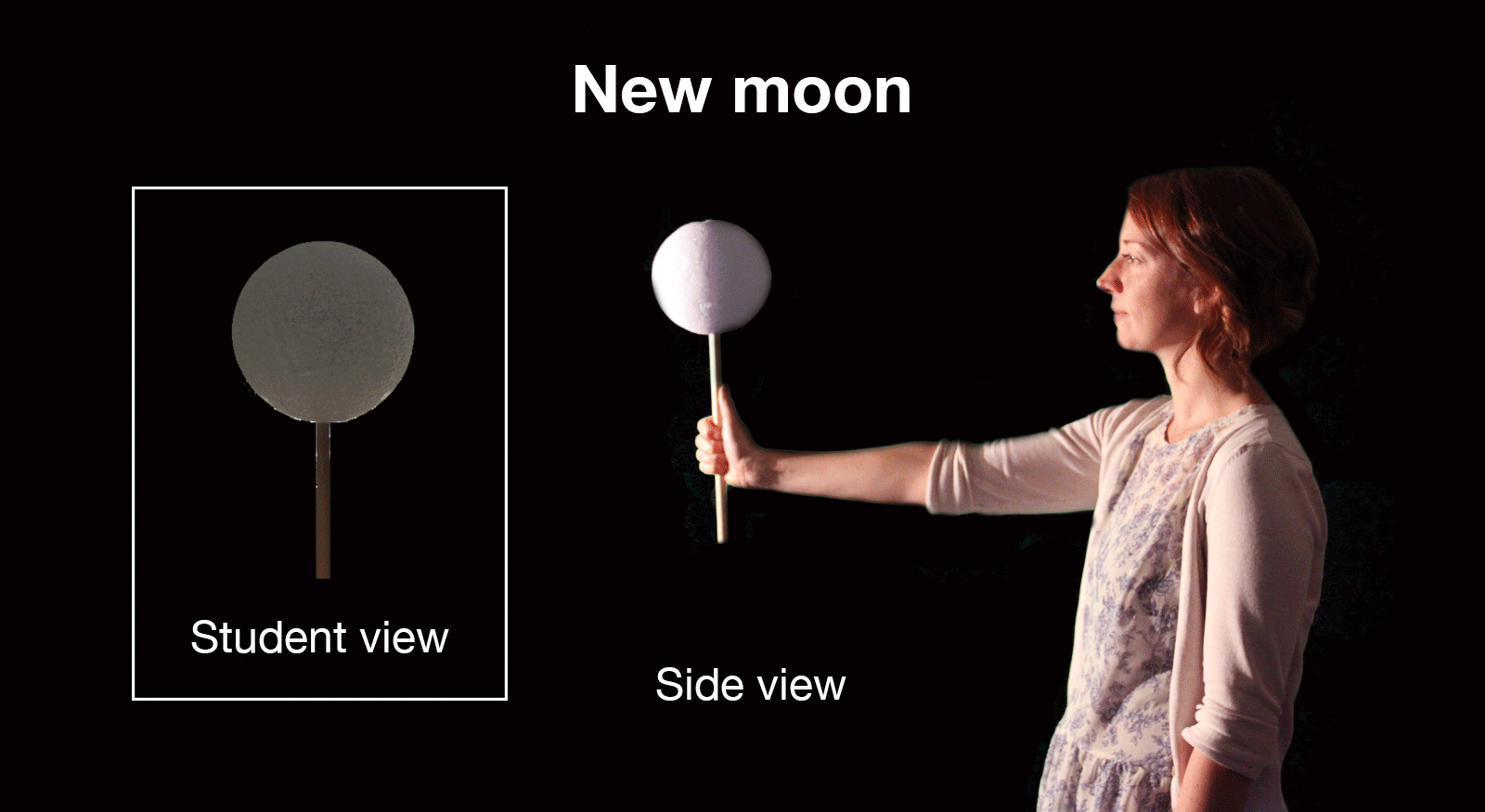 Lesson
LessonMoon Phases
Students learn about the phases of the Moon by acting them out. In 30 minutes, they will act out one complete, 30-day, Moon cycle.
Subject Science
Grades 1-6
Time 30-60 mins
-
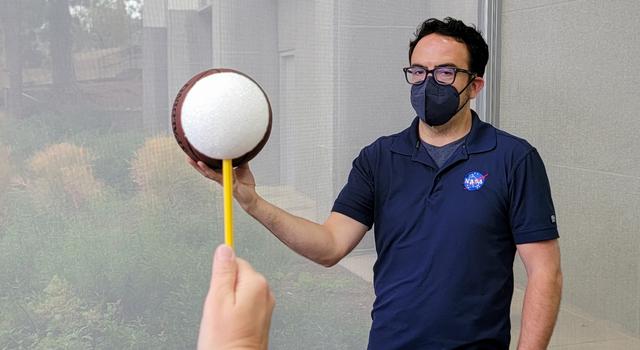 Lesson
LessonModel a Solar Eclipse
Students use simple materials to model a partial, annular, and total solar eclipse.
Subject Science
Grades 1-8
Time 30-60 mins
-
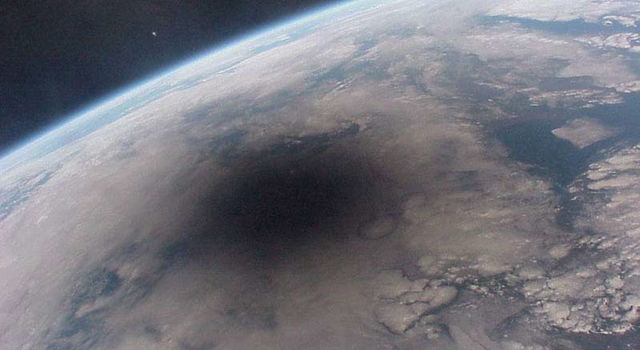 Lesson
LessonMeasuring Solar Energy During an Eclipse
Students use mobile devices to measure the impact a solar eclipse has on the energy received at Earth’s surface.
Subject Math
Grades 4-7
Time 1-2 hrs
-
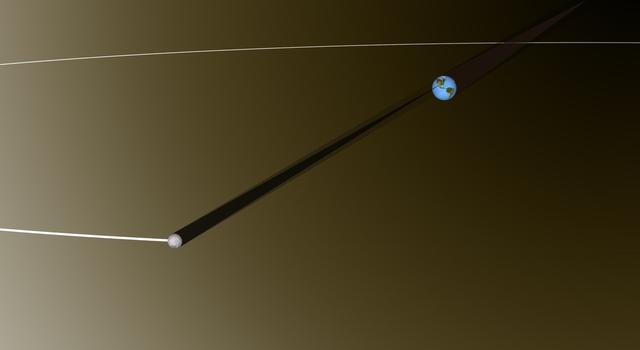 Lesson
LessonModeling the Earth-Moon System
Students learn about scale models and distance by creating a classroom-size Earth-Moon system.
Subject Science
Grades 6-8
Time 30-60 mins
-
 Math Problem
Math ProblemEpic Eclipse
Students use the mathematical constant pi to approximate the area of land covered by the Moon’s shadow during the eclipse.
Subject Math
Grades 6-12
Time < 30 mins
-
 Math Problem
Math ProblemEclipsing Enigma
Students use pi to figure out how much of the Sun’s disk will be covered by the Moon during an eclipse and whether it’s a total or annular eclipse.
Subject Math
Grades 7-12
Time < 30 mins
-
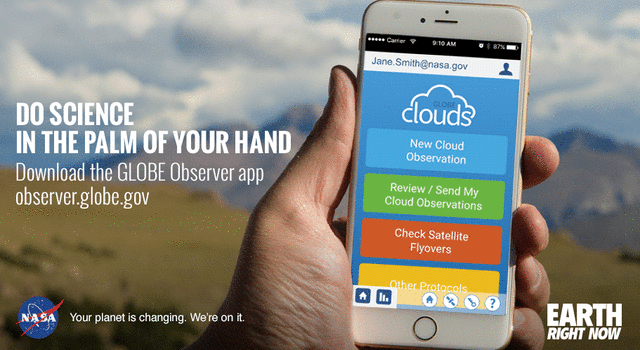 Mobile App
Mobile AppNASA GLOBE Observer App
Students can become citizen scientists and collect data for NASA’s GLOBE Program using this app available for iOS and Android devices.
Explore More
Eclipse Info
- NASA Eclipses Website
- Calendar of Past and Upcoming Eclipses
- Downloadable Eclipse Map
- NASA HEAT Eclipse Training Slide Decks
Eclipse Safety
Interactives
Citizen Science
Facts & Figures
NASA's Universe of Learning materials are based upon work supported by NASA under award number NNX16AC65A to the Space Telescope Science Institute, working in partnership with Caltech/IPAC, Center for Astrophysics | Harvard & Smithsonian, and the Jet Propulsion Laboratory.
TAGS: Solar Eclipse, Eclipse, Annular Eclipse, K-12 Education, Lessons, Classroom Resources, STEM Resources
Teachable Moments | March 7, 2024
A Prime Year for NASA's Pi Day Challenge
Learn how pi is used by NASA and how many of its infinite digits have been calculated, then explore the science and engineering behind the 2024 Pi Day Challenge.
Update: March 15, 2024 – The answers to the 2024 NASA Pi Day Challenge are here! Take a peek at the illustrated answer key now available under each problem on the NASA Pi Day Challenge page.
This year marks the 11th installment of the NASA Pi Day Challenge. Celebrated on March 14, Pi Day is the annual holiday that pays tribute to the mathematical constant pi – the number that results from dividing any circle's circumference by its diameter.
Every year on March 14, Pi Day gives us a reason to enjoy our favorite sweet and savory pies and celebrate the mathematical wonder that helps NASA explore the universe. Students can join in the fun once again by using pi to explore Earth and space themselves with the NASA Pi Day Challenge.
Read on to learn more about the science behind this year's challenge and get students solving real problems faced by NASA scientists and engineers exploring Earth, the Moon, asteroids, and beyond!

Visit the Pi in the Sky 11 lesson page to explore classroom resources and downloads for the 2024 NASA Pi Day Challenge. Image credit: NASA/JPL-Caltech | + Expand image
What is Pi
Dividing any circle’s circumference by its diameter gives you an answer of pi, which is usually rounded to 3.14. Because pi is an irrational number, its decimal representation goes on forever and never repeats. In 2022, mathematician Simon Plouffe discovered the formula to calculate any single digit of pi. In the same year, teams around the world used cloud computing technology to calculate pi to 100 trillion digits. But you might be surprised to learn that for space exploration, NASA uses far fewer digits of pi.
Here at NASA, we use pi to map the Moon, measure Earth’s changing surface, receive laser-coded messages from deep space, and calculate asteroid orbits. But pi isn’t just used for exploring the cosmos. Since pi can be used to find the area or circumference of round objects and the volume or surface area of shapes like cylinders, cones, and spheres, it is useful in all sorts of ways. Transportation teams use pi when determining the size of new subway tunnels. Electricians can use pi when calculating the current or voltage passing through circuits. And you might even use pi to figure out how much fencing is needed around a circular school garden bed.
In the United States, March 14 can be written as 3.14, which is why that date was chosen for celebrating all things pi. In 2009, the U.S. House of Representatives passed a resolution officially designating March 14 as Pi Day and encouraging teachers and students to celebrate the day with activities that teach students about pi. And that's precisely what the NASA Pi Day Challenge is all about!
The Science Behind the 2024 NASA Pi Day Challenge
This 11th installment of the NASA Pi Day Challenge includes four illustrated math problems designed to get students thinking like scientists and engineers to calculate how to get a laser message to Earth, the change in an asteroid’s orbit, the amount of data that can be collected by an Earth satellite, and how a team of mini rovers will map portions of the Moon’s surface.
Read on to learn more about the science and engineering behind each problem or click the link below to jump right into the challenge.
› Take the NASA Pi Day Challenge
› Educators, get the lesson here!
Receiver Riddle
In December 2023, NASA tested a new way to communicate with distant spacecraft using technology called Deep Space Optical Communications, or DSOC. From 19,000,000 miles (30,199,000 km) away, the Psyche spacecraft beamed a high-definition video encoded in a near-infrared laser to Earth. The video, showing a cat named Taters chasing a laser, traveled at the speed of light, where it was received at Caltech’s Palomar Observatory. Because of the great distance the laser had to travel, the team needed to aim the transmission at where Earth would be when the signal arrived. In Receiver Riddle, use pi to determine where along Earth's orbit the team needed to aim the laser so that it could be received at the Observatory at the correct moment.
This animation shows how DSOC's laser signals are sent between the Psyche spacecraft and ground stations on Earth - first as a pointing reference to ensure accurate aiming of the narrow laser signal and then as a data transmission to the receiving station. Credit: NASA/JPL-Caltech/ASU| Watch on YouTube
Daring Deflection
In 2022, NASA crashed a spacecraft into the asteroid Dimorphos in an attempt to alter its orbit. The mission, known as the Double Asteroid Redirection Test, or DART, took place at an asteroid that posed no threat to our planet. Rather, it was an ideal target for NASA to test an important element of its planetary defense plan. DART was designed as a kinetic impactor, meaning it transferred its momentum and kinetic energy to Dimorphos upon impact, altering the asteroid's orbit. In Daring Deflection, use pi to determine the shape of Dimorphos’ orbit after DART crashed into it.

This image shows the final minutes of images leading up to the DART spacecraft's intentional collision with asteroid Dimorphos. Credit: NASA/Johns Hopkins APL | › Enlarge image
Orbit Observation
The NISAR mission is an Earth orbiting satellite designed to study our planet's changing ecosystems. It will collect data about Earth's land- and ice-covered surfaces approximately every 6 days, allowing scientists to study changes at the centimeter scale – an unprecedented level of detail. To achieve this feat, NISAR will collect massive amounts of data. In Orbit Observation, students use pi to calculate how much data the NISAR spacecraft captures during each orbit of Earth.
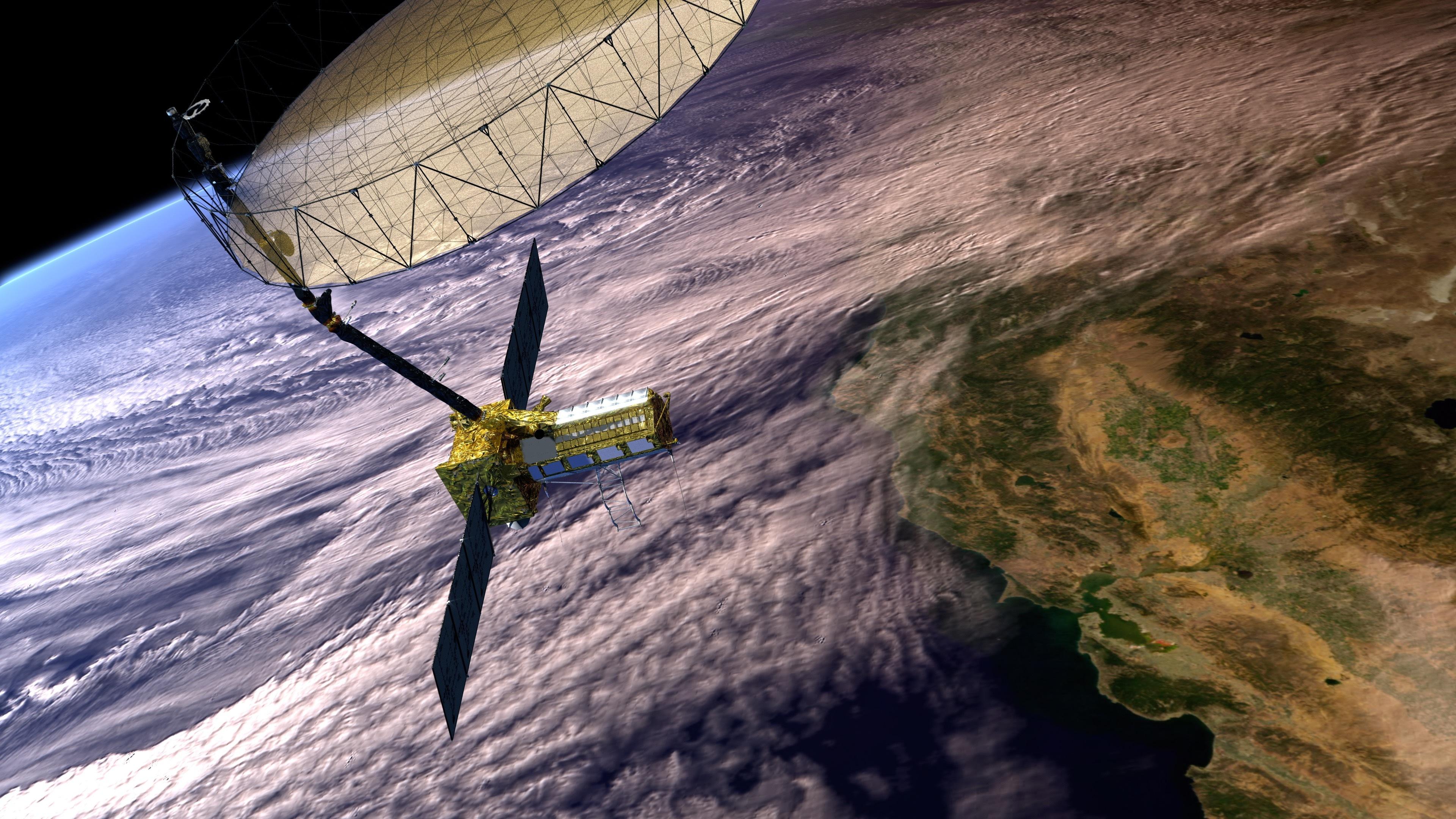
The NISAR satellite, shown in this artist’s concept, will use advanced radar imaging to provide an unprecedented view of changes to Earth’s land- and ice-covered surfaces. Credit: NASA/JPL-Caltech. | › Full image and caption
Moon Mappers
The CADRE project aims to land a team of mini rovers on the Moon in 2025 as a test of new exploration technology. Three suitcase-size rovers, each working mostly autonomously, will communicate with each other and a base station on their lunar lander to simultaneously measure data from different locations. If successful, the project could open the door for future multi-robot exploration missions. In Moon Mappers, students explore the Moon with pi by determining how far a CADRE rover drives on the Moon’s surface.
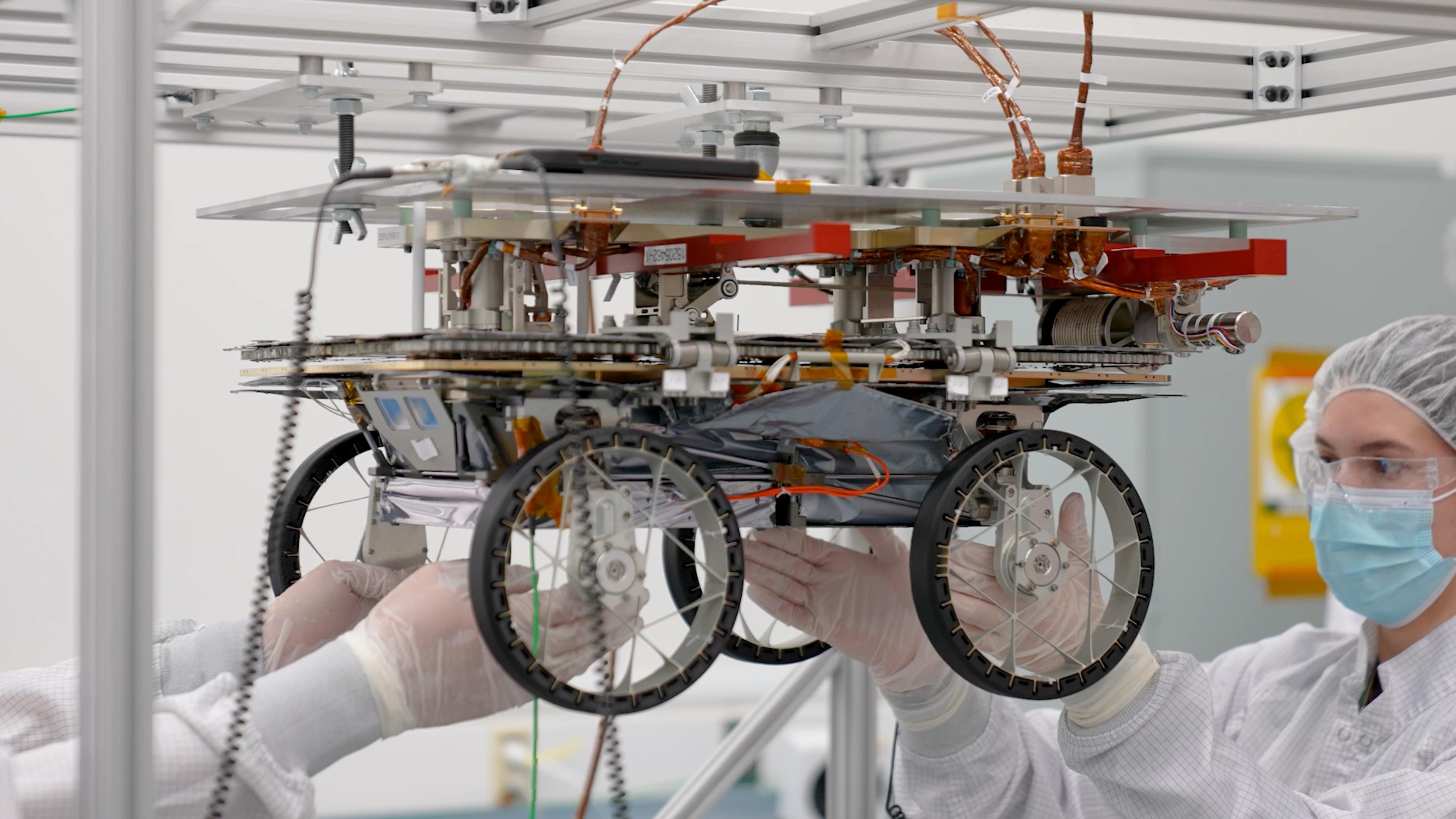
Engineers test the system that will lower three small rovers onto the lunar surface as part of the CADRE project. Credit: NASA/JPL-Caltech | › Full image and caption
Bring the Challenge Into the Classroom
Celebrate Pi Day by getting students thinking like NASA scientists and engineers to solve real-world problems in the NASA Pi Day Challenge. In addition to solving the 2024 challenge, you can also dig into the 40 puzzlers from previous challenges available in our Pi Day collection. Completing the problem set and reading about other ways NASA uses pi is a great way for students to see the importance of the M in STEM.
-
 Collection
CollectionEducator Guides – NASA Pi Day Challenge
Here's everything you need to bring the NASA Pi Day Challenge into the classroom.
Grades 4-12
Time Varies
-
 Student Activity
Student ActivityNASA Pi Day Challenge
The entire NASA Pi Day Challenge collection can be found in one, handy collection for students.
Grades 4-12
Time Varies
-

Downloads
Can't get enough pi? Download this year's NASA Pi Day Challenge graphics, including mobile phone and desktop backgrounds:
More Pi Resources
-
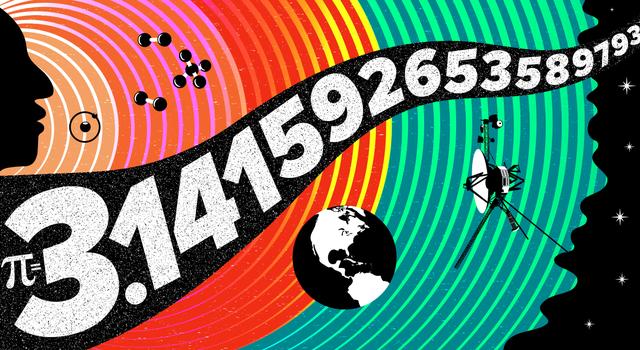 Article
ArticleHow Many Decimals of Pi Do We Really Need?
While you may have memorized more than 70,000 digits of pi, world record holders, a JPL engineer explains why you really only need a tiny fraction of that for most calculations.
-
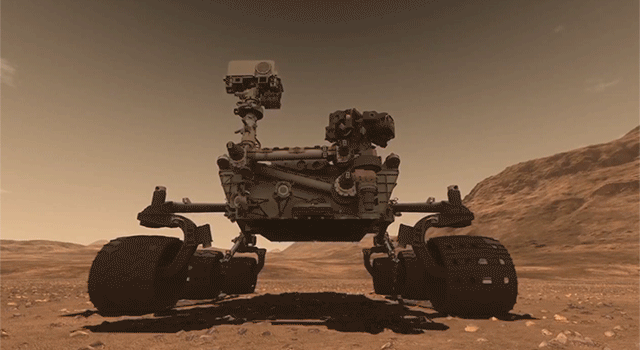 Article
Article18 Ways NASA Uses Pi
Whether it's sending spacecraft to other planets, driving rovers on Mars, finding out what planets are made of or how deep alien oceans are, pi takes us far at NASA. Find out how pi helps us explore space.
- Article
10 Ways to Celebrate Pi Day With NASA on March 14
Find out what makes pi so special, how it’s used to explore space, and how you can join the celebration with resources from NASA.
-
 Infographic
InfographicPlanet Pi
This poster shows some of the ways NASA scientists and engineers use the mathematical constant pi (3.14) and includes common pi formulas.
-
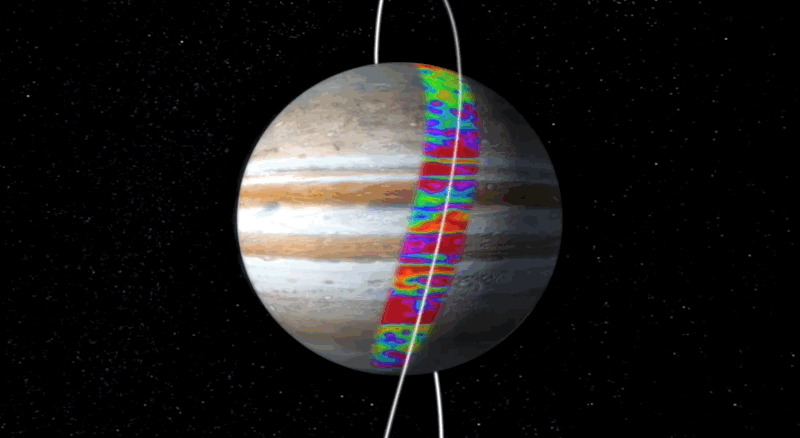 Article
Article18 Maneras en Que la NASA Usa Pi
Pi nos lleva lejos en la NASA. Estas son solo algunas de las formas en que pi nos ayuda a explorar el espacio.
Related Lessons for Educators
-
 Lesson
LessonCollisions in Space
Students predict and observe what happens when two objects collide to model collisions in space.
Grades K-4
Time 30 min to 1 hour
-
 Lesson
LessonMoon Phases
Students learn about the phases of the moon by acting them out.
Grades 1-6
Time 30 min to 1 hour
-
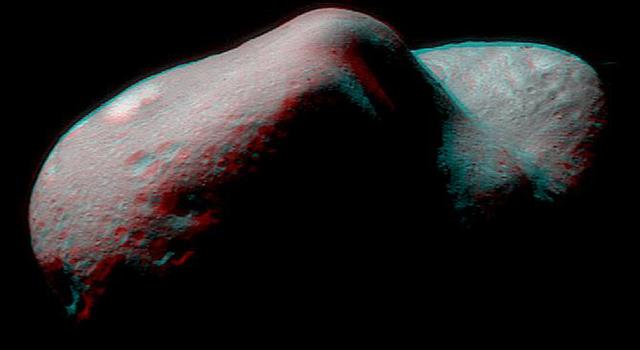 Lesson
LessonModeling an Asteroid
Lead a discussion about asteroids and their physical properties, then have students mold their own asteroids out of clay.
Grades 3-5
Time 30 min to 1 hour
-
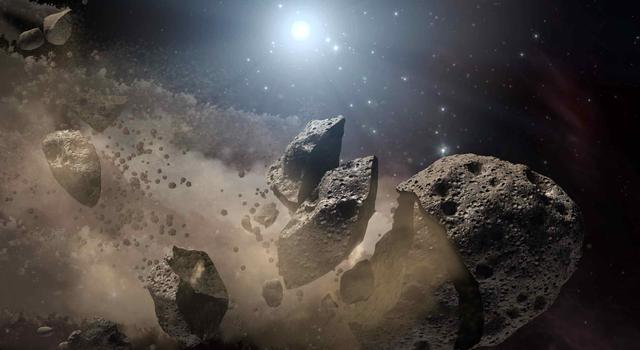 Lesson
LessonMath Rocks: A Lesson in Asteroid Dynamics
Students use math to investigate a real-life asteroid impact.
Grades 8-12
Time 30 min to 1 hour
-
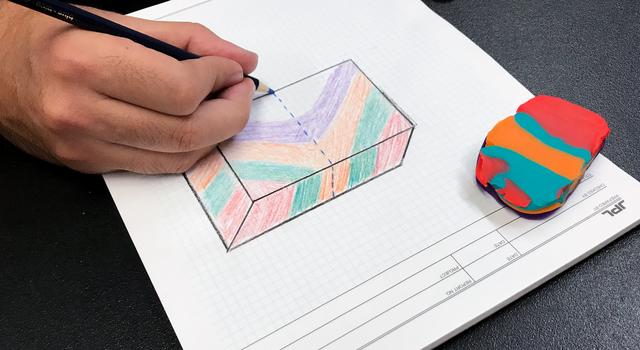 Lesson
LessonModeling Crustal Folds
Students use playdough to model how Earth’s crust is bent and folded by tectonic plates over geologic time.
Grades 6-12
Time 30 min to 1 hour
-
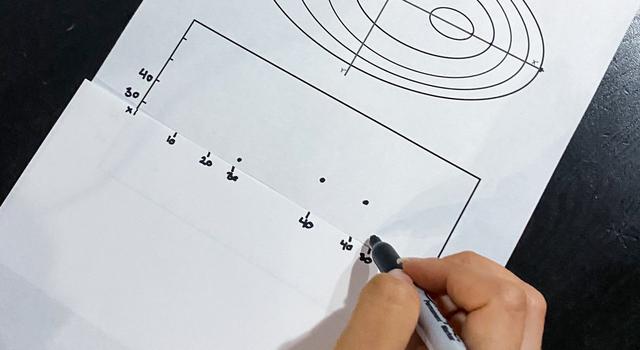 Lesson
LessonMaking Topographic Maps
Students draw and interpret topographic maps while learning about technology used to map Earth's surface, the seafloor, and other worlds.
Grades 6-12
Time 30 min to 1 hour
-
 Lesson
LessonCode a Radio Message for Space
Students code microcontrollers to send and receive radio signals, simulating communications between Earth and spacecraft.
Grades 6-12
Time 30 min to 1 hour
Related Activities for Students
-
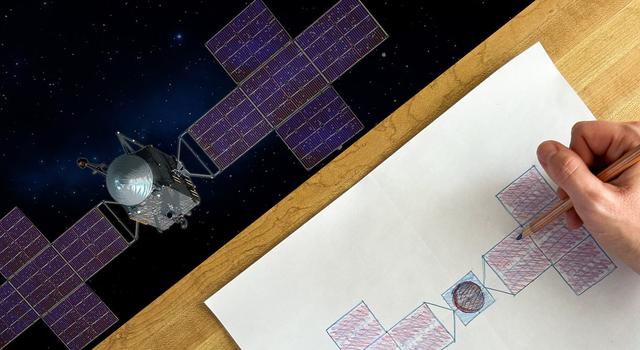 Student Project
Student ProjectDraw Your Own Psyche Spacecraft
Follow these easy instructions to draw and decorate your own model of the Psyche spacecraft.
Type Project
Subject Engineering
-
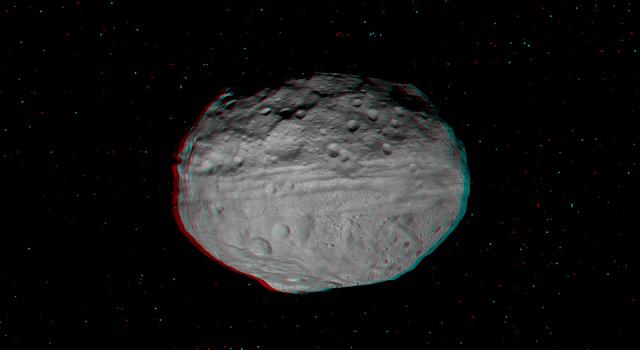 Slideshow
SlideshowWhat's That Space Rock?
Find out how to tell the difference between asteroids, comets, meteors, meteorites and other bodies in our solar system.
Type Slideshow
Subject Science
Facts and Figures
Websites
Articles
- How NASA Studies and Tracks Asteroids Near and Far
- NASA Cat Video Explained
- Article for Kids: Asteroid or Meteor: What's the Difference?
- Article for Kids: What Is an Asteroid?
Videos
- The Video NASA’s Laser Communications Experiment Streamed From Deep Space
- NASA's DART Mission Confirms Crashing Spacecraft into Asteroids Can Deflect Them
Interactives
TAGS: Pi Day, Pi, Math, NASA Pi Day Challenge, moon, earth, asteroid, psyche, DART, CADRE, NISAR DSOC
Edu News | August 17, 2023
Spend the School Year With NASA-JPL
Make educational connections to NASA and JPL happenings all year long with this calendar of upcoming events and links to educational resources you can use to explore STEM with us throughout the 2023-2024 school year.
August
All Month – Go Back to School With Us
The start of the school year is a great time to explore all of the resources we have on offer for educators, parents, and K-12 students. These include everything from classroom activities to DIY student projects to video tutorials to expert talks to our Teachable Moments series, which offers education-focused explainers of the latest NASA news.
There's something for every day of the school year, and you can find it all in one place on our Back to School event page. You can also sign up to receive monthly updates about new and featured content as well as upcoming events in your inbox with the JPL Education newsletter.
Learning Resources
-
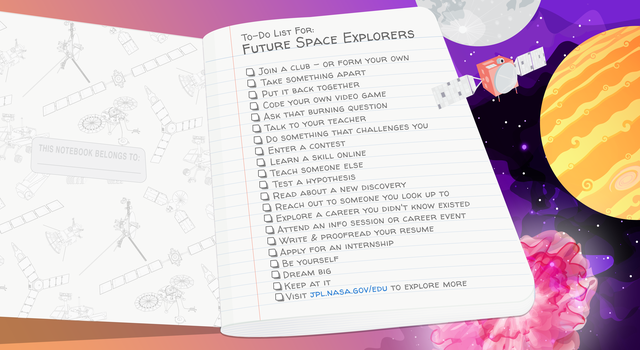 Public Event
Public EventBack to School With NASA-JPL Education
All the resources you'll need for a stellar school year from classroom lessons to student activities, challenges, and more!
-
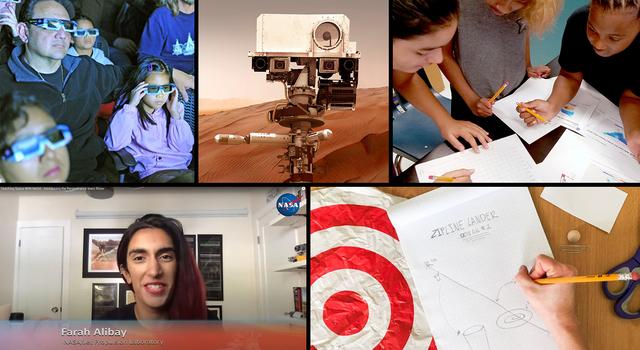 Sign Up
Sign UpJPL Newsletter
Sign up to receive the latest STEM education resources, events, and news for teachers, students, and parents from the education team at JPL.
August 30 – See Supermoons on Parade
Skygazers will have plenty to moon over in August as the second of two supermoons this month graces the sky on August 30.
Make the event a Teachable Moment by dispelling common misconceptions about supermoons and digging into the real science behind the phenomena. Get students acting out moon phases, then have them apply what they've learned to make a Moon phases calendar and calculator. Plus, explore even more classroom activities and DIY projects all about our Moon.
Learning Resources
-
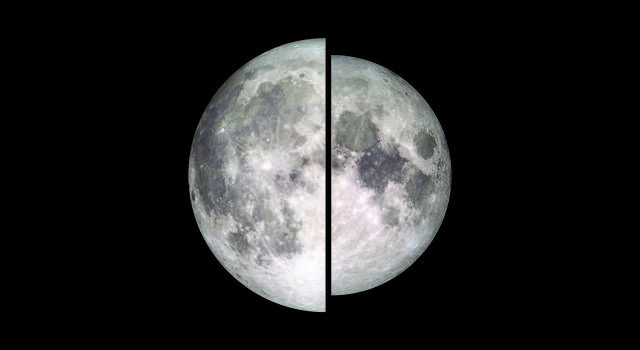 Teachable Moments
Teachable MomentsWhat’s a Supermoon and Just How Super Is It?
Here’s what you can really expect to see during a supermoon. You don’t have to take our word for it. Get students investigating themselves.
-
 Collection
CollectionMoon Lessons for Educators
Teach students about the Moon with this collection of standards-aligned activities inspired by real NASA missions and science.
-
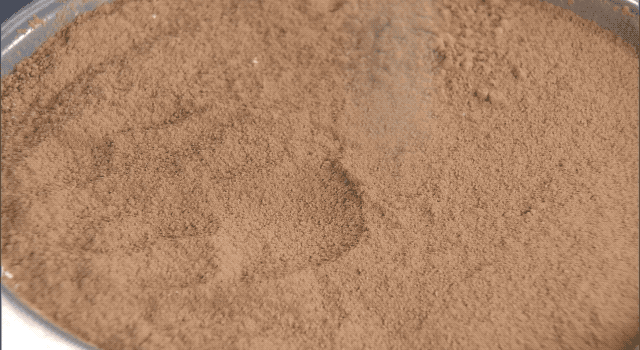 Collection
CollectionMoon Activities for Students
Learn all about the Moon with these projects, slideshows, and videos for students.
September
September 24 – Follow Along as Asteroid Samples Arrive on Earth
Samples collected from the surface of an asteroid parachuted down to Earth on September 24, landing about 70 miles west of Salt Lake City. The samples were collected by the OSIRIS-REx spacecraft, which gathered the material during a daring descent on asteroid Bennu in 2018. The mission, which marks the first time the U.S. has collected samples from an asteroid, will give scientists an unparalleled, up-close look at remnants from our early solar system.
Follow along with the mission by having students do some of the same math as OSIRIS-REx mission planners. Or, have them do their own asteroid-related experiments. It's also a great opportunity to make connections to another NASA sample-return mission.
Learning Resources
-
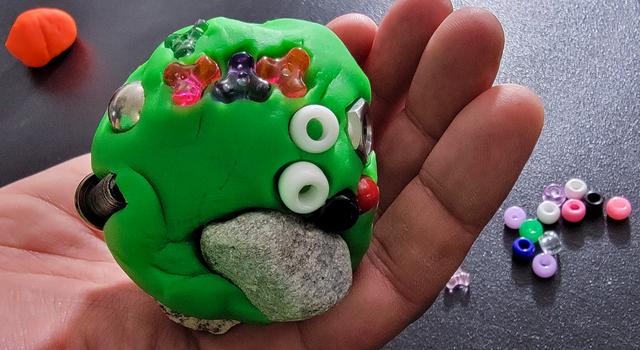 Collection
CollectionAsteroids Lessons for Educators
Explore a collection of standards-aligned lessons all about asteroids and craters.
-
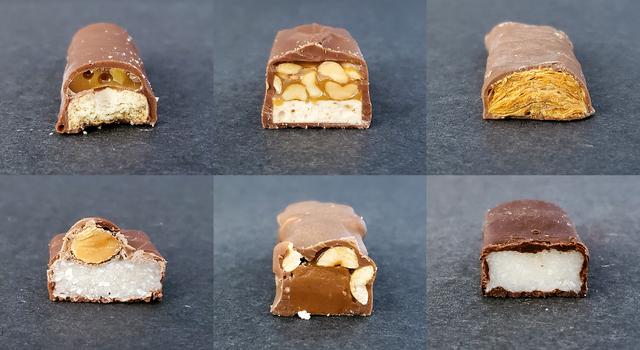 Collection
CollectionAsteroids Activities for Students
Explore projects, videos, slideshows, and games for students all about asteroids.
October
October 12 – Join NASA for the Psyche Launch
Did you know we can explore asteroids and other far away objects in the solar system to learn more about the interior of our own planet? That's one of the goals of NASA's Psyche mission, which is slated to launch on October 12 from NASA's Kennedy Space Center in Florida. The mission is designed to explore an asteroid – also named Psyche – that may be the remnant of a planet's core.
The Psyche spacecraft is one of just a handful of NASA missions throughout history that have used electric propulsion rather than a chemical engine, which means it's also a great opportunity to make connections to real-world examples of motion and forces. Get a primer on all the engineering and science behind the mission from our Teachable Moments series, then explore related lessons and projects.
Learning Resources
-
 Article
ArticleTeachable Moments: Asteroid Mission Aims to Explore Mysteries of Earth's Core
Explore how NASA's Psyche mission aims to help scientists answer questions about Earth and the formation of our solar system.
-
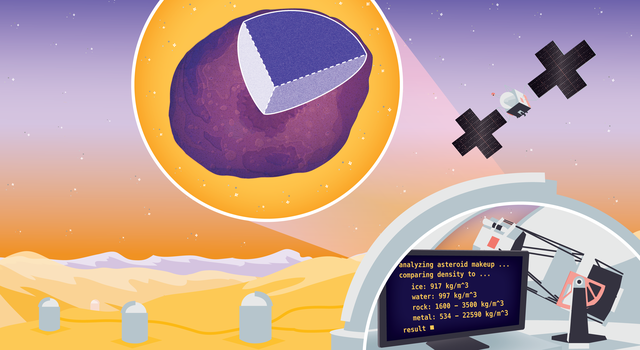 Collection
CollectionPsyche Lessons for Educators
Explore a collection of standards-aligned lessons related to NASA's Psyche mission.
-
 Collection
CollectionPsyche Activities for Students
Explore projects, videos, slideshows, and games for students all about asteroids.
October 14 – Catch the Annular Solar Eclipse
October 14 marks the start of another exciting double-feature for skygazers: an annular solar eclipse followed by a total solar eclipse just six months later. In both events, the Sun, Moon, and Earth will align, creating a spectacular sight in the sky. But during the annular solar eclipse on October 14, a ring of sunlight will remain visible around the Moon. This is due to differences in the relative distances between the Sun, Moon, and Earth during the eclipse. In any case, remember to never look directly at the Sun without proper protection, such as certified solar eclipse glasses.
Another fun way to view a solar eclipse is by making a pinhole camera. Students can even use their pinhole cameras to make solar art. Check out our Teachable Moments article for more info on where and when to watch the eclipse, plus a primer on the science of solar eclipses. And explore even more eclipse lessons and activities – including a math puzzler from our NASA Pi Day Challenge.
Learning Resources
-
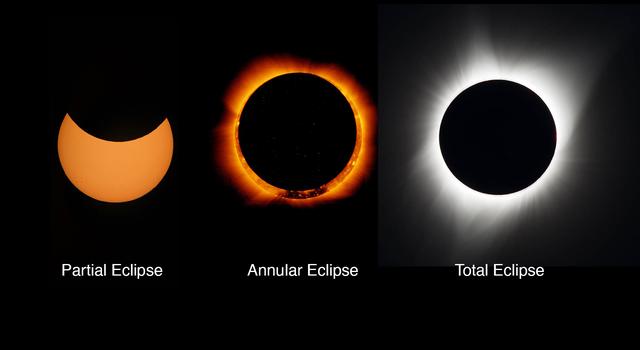 Teachable Moment
Teachable MomentThe Science of Solar Eclipses and How to Watch With NASA
Get ready for the annular solar eclipse on Oct. 14, 2023. Learn about the science behind solar eclipses, how to watch safely, and how to engage students in NASA science.
-
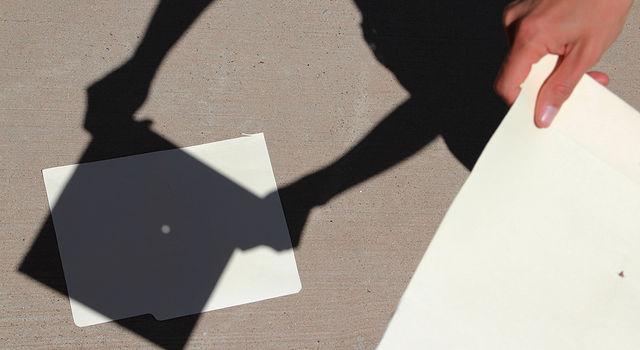 Student Project
Student ProjectHow to Make a Pinhole Camera
Learn how to make your very own pinhole camera to safely see a solar eclipse in action!
-
 Lesson
LessonModel a Solar Eclipse
Students use simple materials to model a partial, annular, and total solar eclipse.
-
 Math Problem
Math ProblemEclipsing Enigma: A ‘Pi in the Sky’ Math Challenge
In this illustrated math problem, students use pi to figure out how much of the Sun’s disk will be covered by the Moon during an eclipse and whether it’s a total or annular eclipse.
Oct. 31 – Dare Mighty Pumpkins
Every Halloween, during an annual contest held at JPL, our engineers join kids and families across the country in the hallowed tradition of pumpkin carving. But these aren't your average jack-o'-lanterns. JPL pumpkins from years past have included a simulated Moon landing, Mars-themed whack-a-mole, and an exploding pumpkin supernova. The event, which takes place during employees' lunch break, gives all-new credence to the Lab's unofficial motto, "Dare Mighty Things." And it's good timing because this Halloween is also JPL's 87th birthday.
Whether history or Halloween are your thing, we've got ways to make educational connections – including a DIY project that gets students daring mighty pumpkins, themselves.
Learning Resources
-
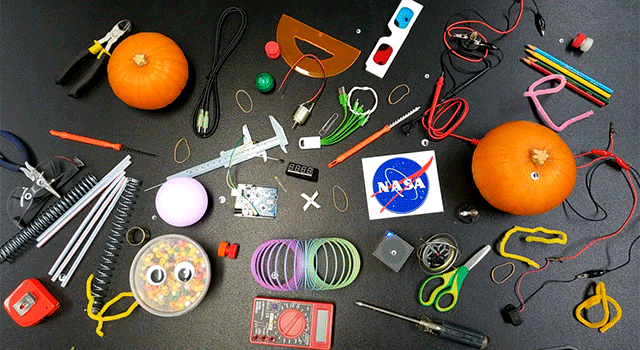 Collection
CollectionHalloween Activities for Students
Explore student projects and slideshows that put a Halloween twist on STEM.
-
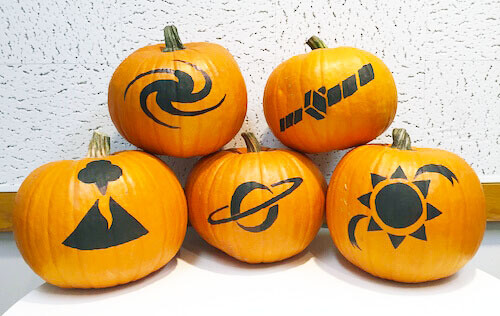 For Kids
For KidsHalloween Activities and Articles for Kids
Explore Halloween activities from NASA's Space Place, including pumpkin stencils, planet masks, an a scary space slideshow.
-
 Articles
ArticlesTeachable Moments: JPL History
Explore key moments in JPL history and how they connect to what students are learning now.
November
All Month – Explore STEM Careers
Take part in National Career Development Month in November by exploring STEM opportunities at NASA and JPL. Students can learn more about careers in STEM and hear directly from scientists and engineers working on NASA missions in our Teaching Space video series. Meanwhile, our news page has more about what it takes to be a NASA astronaut and what it's like to be a JPL intern. You can also explore a collection of stories about NASA people, Women at NASA, and Women at JPL, to learn more about the work they do.
For students already in college and pursuing STEM degrees, it's never too soon to start exploring internship opportunities for the summer. The deadline for JPL summer internships is March 29, so refresh your resume and get your application started now. Learn how to stand out with this article on how to get an internship at JPL – which also includes advice for pre-college students.
Learning Resources
-
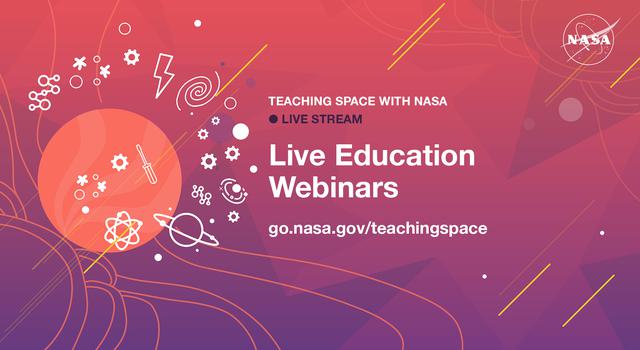 Expert Talks
Expert TalksTeaching Space With NASA
Hear from experts and education specialists about the latest missions and science happening at NASA and get your questions answered.
-
 Articles
ArticlesCareer Guidance
Get advice from scientists, engineers and educators about what it takes to work in science, technology, engineering and mathematics fields and how to get a foot in the door.
-
 Articles
ArticlesMeet JPL Interns
These interns are pushing the boundaries of space exploration and science at the leading center for robotic exploration of the solar system.
-
 Opportunities
OpportunitiesInternships and Jobs at JPL and NASA
Discover exciting opportunities at the leading NASA center for robotic exploration of the solar system.
December
All Month – Send Your Name to Jupiter
Here's a gift idea that doesn't cost a thing: Send a loved one's name to Jupiter with NASA's Europa Clipper mission. December is the last month to add your name to a microchip that will be flown on the spacecraft along with a poem written by the U.S. Poet Laureate, Ada Limón. The Europa Clipper mission, which is scheduled to launch in October 2024, is designed to explore Jupiter's ice-covered ocean moon Europa – the newest frontier in our search for life beyond Earth. So don't miss the boat – or, in this case, spacecraft – on this exciting opportunity.
Explore activities students can do in class or over winter break to write their own space poetry and engage in hands-on activities and experiments related to the Europa Clipper mission.
Learning Resources
-
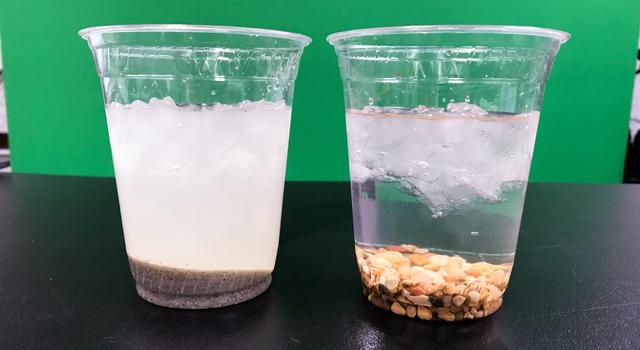 Collection
CollectionEuropa Lessons for Educators
Explore classroom activities to bring the excitement of STEM and NASA's Europa Clipper mission to students.
-
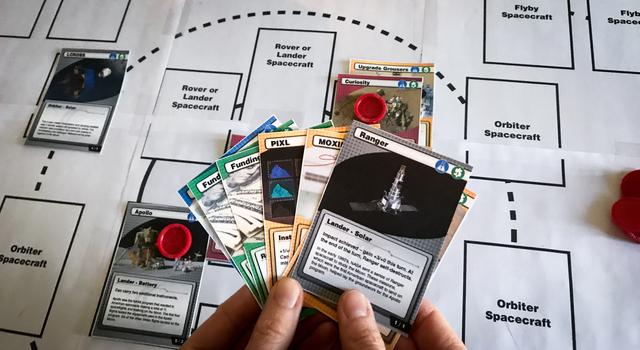 Collection
CollectionEuropa Activities for Students
Learn all about Jupiter's moon Europa with these projects and videos for students.
-
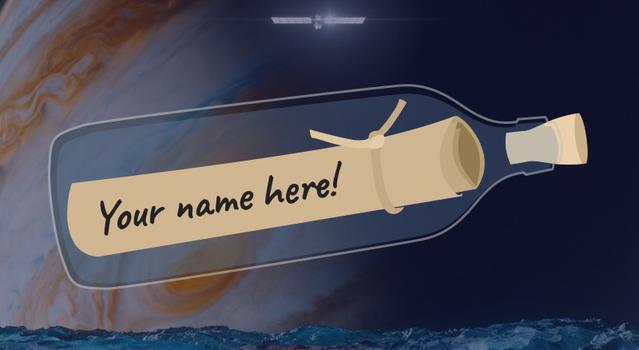 Public Event
Public EventSend Your Name to Jupiter
Have your name engraved on NASA's Europa Clipper spacecraft. Plus, explore more ways you can participate with the mission.
-
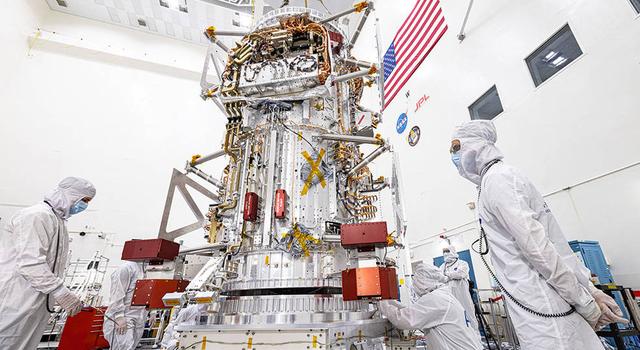 Live Stream
Live StreamWatch Engineers Build Europa Clipper Live at JPL
Get a live view into the "cleanroom" at NASA's Jet Propulsion Laboratory, where engineers are building the Europa Clipper spacecraft.
All Month – Prepare for the Science Fair
Before you know it, it'll be science fair time. Avoid the stress of science fair prep by getting students organized and thinking about their projects before the winter recess. Start by watching our video series How to Do a Science Fair Project. A scientist and an engineer from JPL walk your students through all the steps they will need to create an original science fair project by observing the world around them and asking questions.
You can also explore our science fair starter pack of lessons and projects to get students generating ideas and thinking like scientists and engineers.
Learning Resources
-
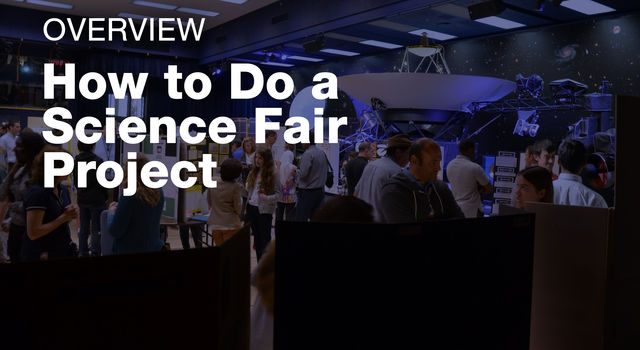 Video Series
Video SeriesHow to Do a Science Fair Project
Learn all the ins and outs of crafting your very own science fair project.
-
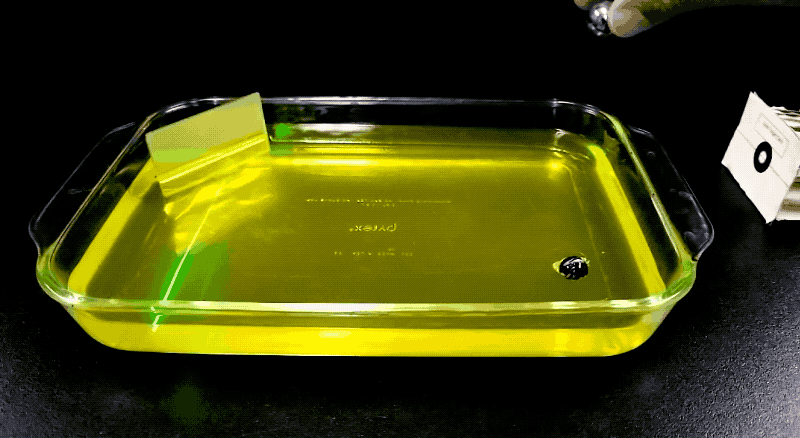 Collection
CollectionScience Fair Lessons for Educators
Teach students how to craft their own science and engineering fair project with these video tutorials and lessons featuring NASA missions and science.
-
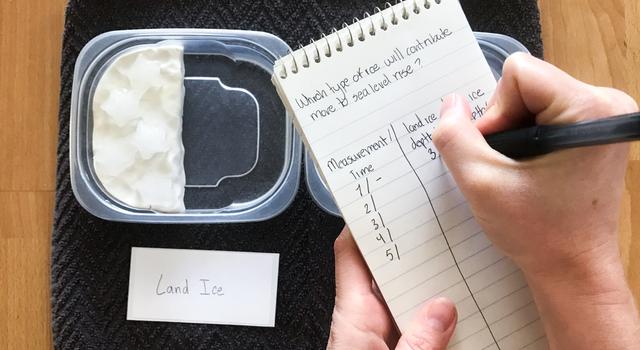 Collection
CollectionScience Fair Activities for Students
Learn how to design a science and engineering fair project and get inspired with our catalog of student projects featuring NASA missions and science.
January
January 4 - Take a Closer Look at Jupiter's 'Pizza Moon'
Everyone's favorite pizza moon is getting another series of close-ups from NASA's Juno mission. Now that Juno has completed its primary science goals, mission planners are tweaking the spacecraft's orbit to send it past some of Jupiter's most fascinating moons. Io – notable for the more than 150 active volcanoes that splotch its surface like a bubbling cheese pizza – is next on the docket with two planned flybys this school year. Keep an eye on the mission website for updates and images from the first flyby on Dec. 30, 2023 that you can use to engage students before the second flyby on Feb. 3, 2024.
While on the topic of Juno, which holds the title of the most distant solar-powered spacecraft, it's a great opportunity to segue into math lessons involving pi, exponents, and the inverse square law. Or, highlight another record-holder: Rosaly Lopes, the JPL scientist who discovered 71 active volcanoes on Io, for which she was given the 2006 Guiness World Record for her discovery of the most active volcanoes anywhere.
Learning Resources
-
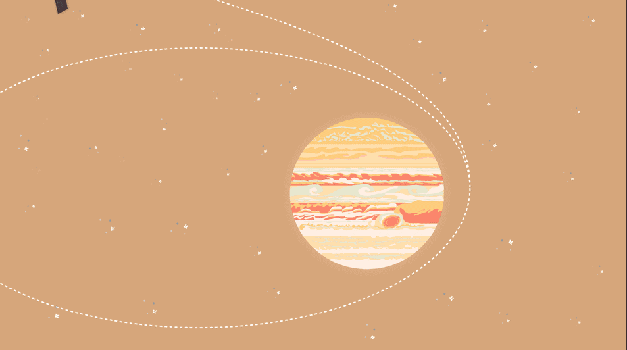 Collection
CollectionJuno Lessons for Educators
Explore classroom activities to bring the excitement of STEM and NASA's Juno mission to students.
-
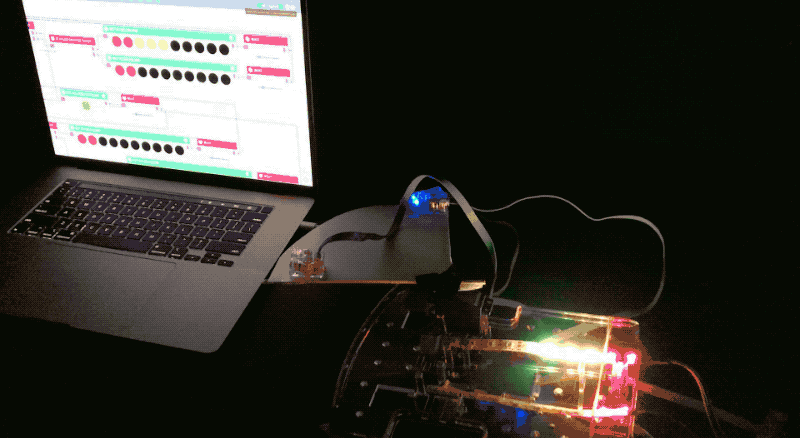 Collection
CollectionJuno Activities for Students
Learn all about NASA's Juno mission with these projects, slideshows, and videos for students.
-
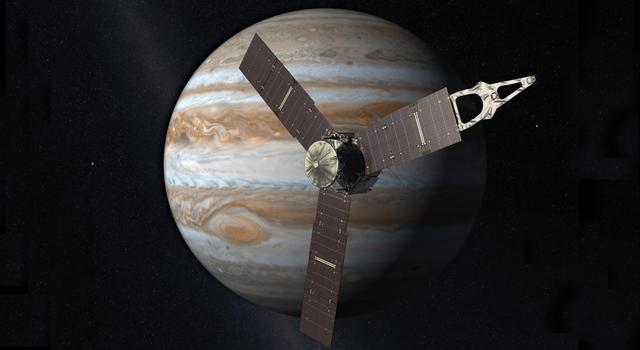 Teachable Moments
Teachable MomentsCruising to Jupiter: A Powerful Math Lesson
Find out how NASA’s Juno mission at Jupiter earned the title of most distant solar-powered spacecraft and how it relates to exponents.
February
February 18 – Learn What's Next for Mars Exploration
February 18 marks three years since NASA's Perseverance rover touched down on Mars, sticking the landing on one of the riskiest Red Planet descents to date. While the rover is coring away on Mars, collecting a diverse array of scientifically intriguing samples, mission teams here are busy designing, developing, and testing various devices to bring those samples to Earth. While we've collected samples from other objects in the solar system before (see October's asteroid sample return), this would be the first time we've retrieved samples from another planet. It requires an ambitious plan executed by multiple teams that need to achieve a number of other firsts – including the first launch from another planet.
Get students following along with classroom activities, projects, and challenges that have them apply their coding and collaboration skills to designing their own Mars sample return missions.
Learning Resources
-
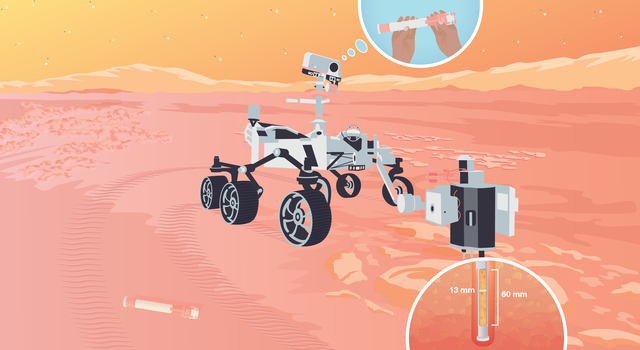 Collection
CollectionMars Sample Return Lessons for Educators
Explore classroom activities to bring the excitement of STEM and NASA's Mars Sample Return mission to students.
-
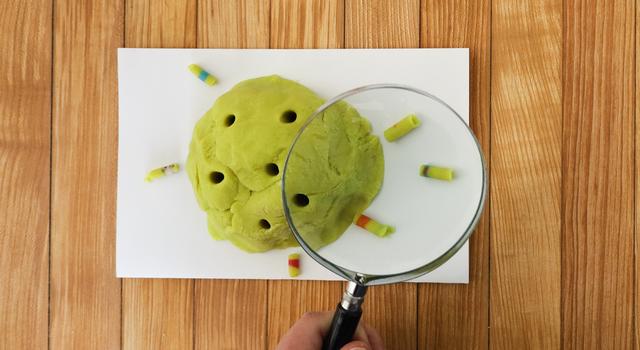 Collection
CollectionMars Sample Return Activities for Students
Learn all about NASA's Mars Sample Return mission with these projects for students.
-
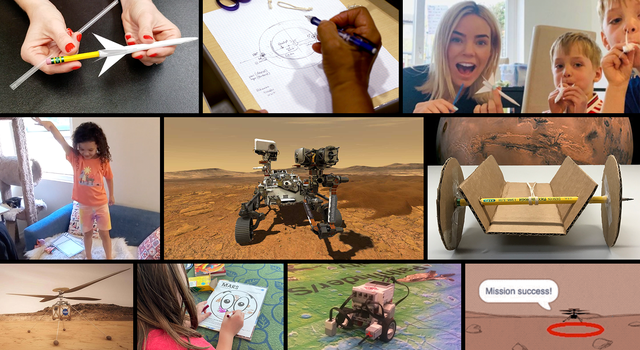 Collection
CollectionMission to Mars Student Challenge
Get K-12 students exploring Mars with NASA scientists, engineers, and the Perseverance rover as they learn all about STEM and design their very own mission to the Red Planet!
-
 Teachable Moments
Teachable MomentsNASA's Perseverance Rover Lands on Mars
Learn how, why, and what Perseverance will explore on Mars, plus find out about an exciting opportunity for you and your students to join in the adventure!
March
March 7-15 – Take the NASA Pi Day Challenge
There's more than pie to look forward to on March 14 as we'll be releasing an all-new set of Pi Day Challenge math problems involving NASA missions and science. Look for the latest problem set along with links to more resources and ways to celebrate Pi Day with us starting on March 7. You can get a sneak peek with the resources below, which work all year long, even without the slice of pie – although, we wouldn't blame you if you had one anyway.
Learning Resources
-
 Collection
CollectionPi in the Sky Lessons
Find everything you need to bring the NASA Pi Day Challenge into the classroom, including printable handouts of each illustrated math problem.
-
 Student Project
Student ProjectNASA Pi Day Challenge
This collection of illustrated math problems gets students using pi like NASA scientists and engineers exploring Earth and space.
-
 Article
ArticleHow Many Decimals of Pi Do We Really Need?
While you may have memorized more than 70,000 digits of pi, world record holders, a JPL engineer explains why you really only need a tiny fraction of that for most calculations.
-
 Article
Article18 Ways NASA Uses Pi
Whether it's sending spacecraft to other planets, driving rovers on Mars, finding out what planets are made of or how deep alien oceans are, pi takes us far at NASA. Find out how pi helps us explore space.
April
April 8 – Watch the Total Solar Eclipse
Time to get some solar eclipse glasses and dig out your pinhole cameras once again – this time for the headliner, a total solar eclipse on April 8. The eclipse will start in the South Pacific Ocean before passing over Mexico and following a diagonal path northeast over the U.S. and Canada. NASA is holding community events across the country where you can hear from speakers and participate in activities. Learn more on the agency's web page for all things solar eclipse.
Whether you're covering eclipse topics for the first time this school year or expanding on learning from October, this solar eclipse is a good time to get students exploring more about the science of eclipses. Start by looking at the five science experiments NASA has funded for the 2024 solar eclipse, then have students investigate solar eclipse science for themselves.
Learning Resources
-
 Teachable Moment
Teachable MomentThe Science of Solar Eclipses and How to Watch With NASA
Learn about the science behind solar eclipses, how to watch safely, and how to engage students in NASA science.
-
 Student Project
Student ProjectHow to Make a Pinhole Camera
Learn how to make your very own pinhole camera to safely see a solar eclipse in action!
-
 Lesson
LessonModel a Solar Eclipse
Students use simple materials to model a partial, annular, and total solar eclipse.
-
 Math Problem
Math ProblemEclipsing Enigma: A ‘Pi in the Sky’ Math Challenge
In this illustrated math problem, students use pi to figure out how much of the Sun’s disk will be covered by the Moon during an eclipse and whether it’s a total or annular eclipse.
April 22 - Celebrate Earth Day With NASA
You may not immediately think of Earth science when you think of NASA, but it's a big part of what we do. Earth Day on April 22 is a great time to learn more about our Earth and climate science projects and missions, especially with the much anticipated NISAR mission taking to the skies in 2024 to track minute changes in the planet's surface, including those from natural hazards such as earthquakes, tsunamis, volcanoes and landslides.
Whether you want to focus on Earth’s surface and geology, climate change, extreme weather, or the water budget, we have an abundance of lessons, student projects and Teachable Moments to guide your way.
Learning Resources
-
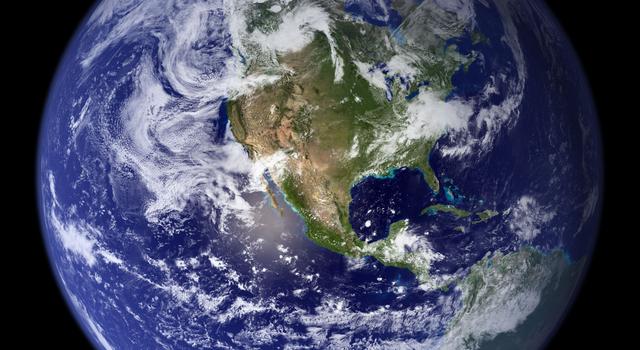 Collection
CollectionEarth Lessons for Educators
Discover a collection of standards-aligned STEM lessons all about Earth and climate change.
-
 Collection
CollectionEarth Activities for Students
Try these science and engineering projects, watch videos, and explore images all about the planet that we call home.
-
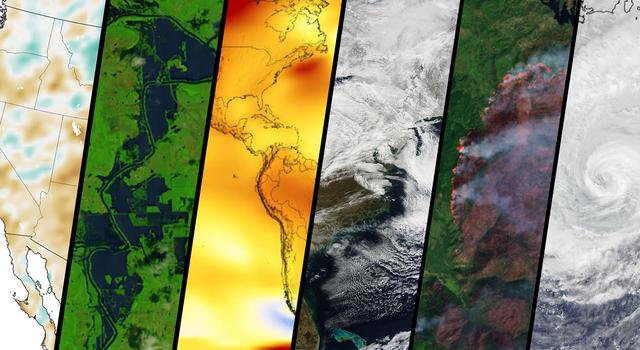 Teachable Moments
Teachable MomentsClimate Change Collection
Explore this collection of Teachable Moments articles to get a primer on the latest NASA Earth science missions, plus find related education resources you can deploy right away!
May
May 6-10 – Give Thanks to Teachers and Black Holes
It may not seem like there's much to be gained from the dual programming of Black Hole Week and Teacher Appreciation Week on May 6-10, but sending students off to learn more about everyone's favorite spacely phenomenon might just give teachers the breather they deserve after a busy school year.
Have students dig into the science of black holes or even try out an experiment to learn how a black hole collision helped prove the existence of gravitational waves. Meanwhile, teachers can learn about all the ways their work has inspired us.
Learning Resources
-
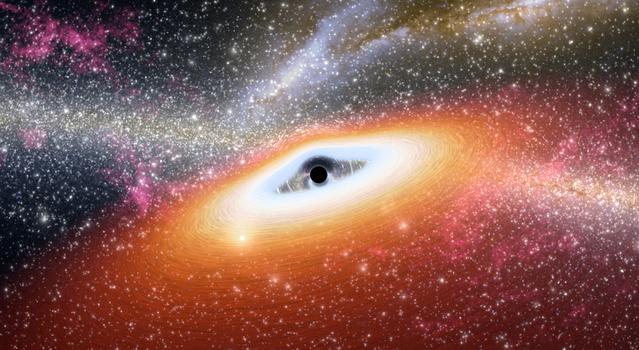 Slideshow
SlideshowBlack Holes: By the Numbers
What are black holes and how do they form?
-
 Lesson
LessonDropping In With Gravitational Waves
Students develop a model to represent the collision of two black holes, the gravitational waves that result and the waves' propagation through spacetime.
-
 Articles
ArticlesTeachable Moments: Black Holes
Learn about the latest discoveries in black hole science and how to make connections to what students are learning.
-
 Share
ShareThank You, Teachers!
Employees at NASA's Jet Propulsion Laboratory give thanks to the teachers who helped them reach for the stars.
All Month – Launch Into Summer
Speaking of black holes, don't let students' learning fall into one as the summer gets into full swing. Send them off with links to these DIY summer projects. There's even more for parents and families on our Learning Space With NASA at Home page, which also has information to help direct students' learning during out-of-school time.
Learning Resources
-
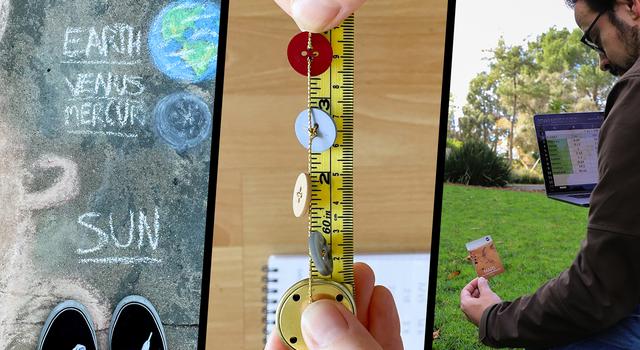 Student Resources
Student ResourcesSummer Activities for Students
Explore Earth and space with these hands-on projects, slideshows, videos, and more for K-12 students.
-
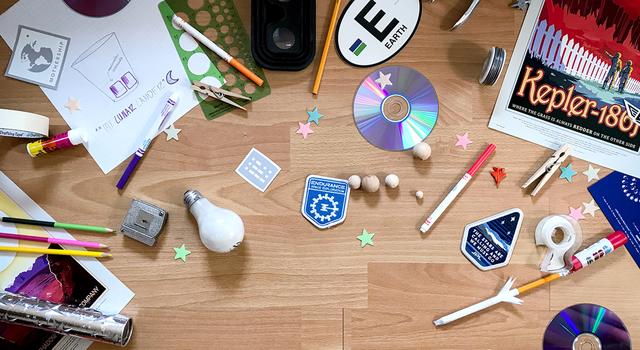 Student Resources
Student ResourcesLearning Space With NASA
Explore space and science activities you can do with NASA at home. Find video tutorials, DIY projects, slideshows, games and more!
TAGS: Teachers, Classroom, Lessons, Educators, K-12, Parents, Students, Resources
Teachable Moments | August 16, 2023
Asteroid Mission Aims to Explore Mysteries of Earth's Core
Explore how NASA's Psyche mission aims to help scientists answer questions about Earth and the formation of our solar system. Then, make connections to STEM learning in the classroom.
NASA is launching a spacecraft in October 2023 to visit the asteroid Psyche, a metal-rich asteroid. The mission with the same name, Psyche, will study the asteroid, which is located in the main asteroid belt between Mars and Jupiter, to learn more about our solar system, including the core of our own planet.
Read more to find out what we will learn from the Psyche mission. Get to know the science behind the mission and follow along in the classroom using STEM teaching and learning resources from NASA.
Why It's Important
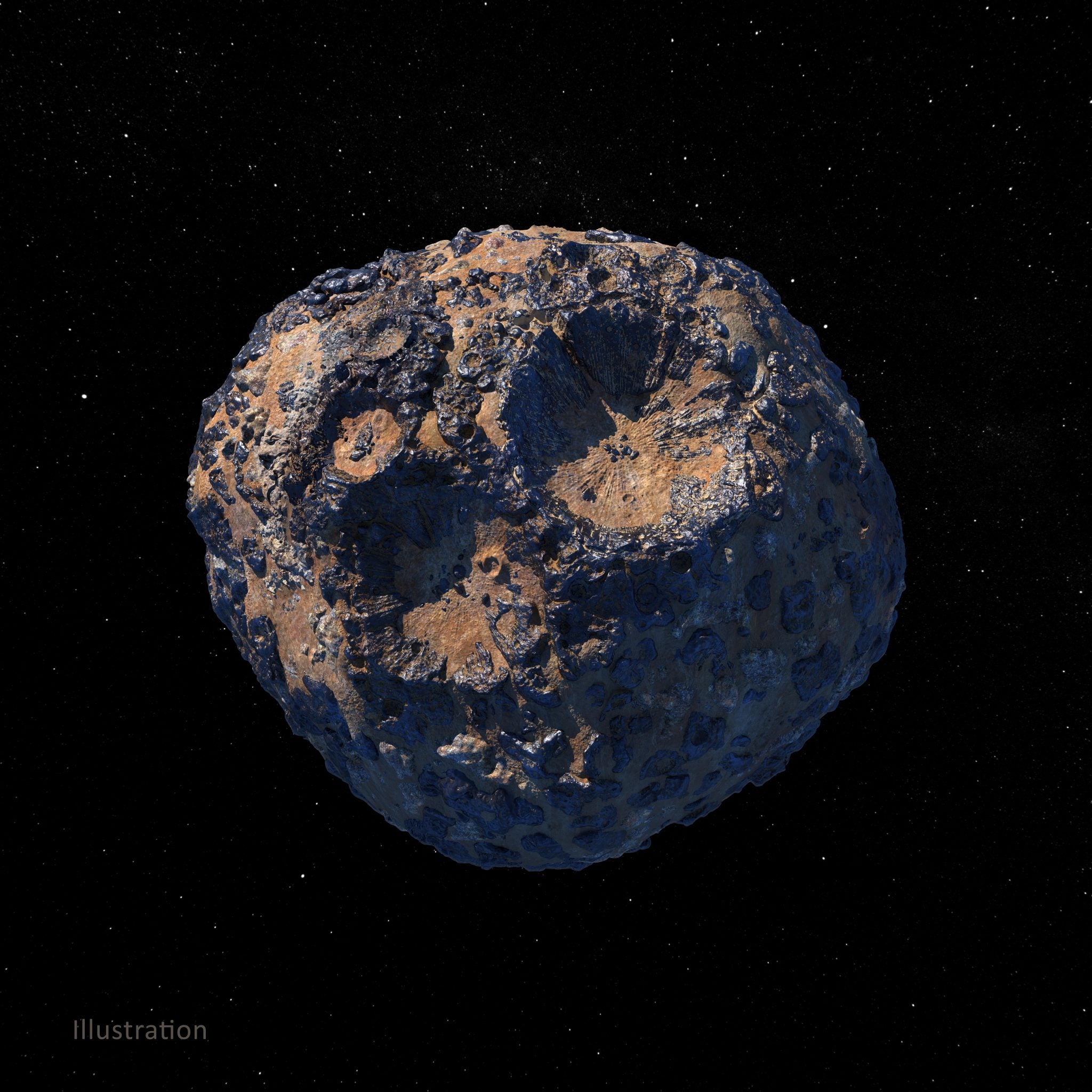
This illustration depicts the 140-mile-wide (226-kilometer-wide) asteroid Psyche, which lies in the main asteroid belt between Mars and Jupiter. Credit: NASA/JPL-Caltech/ASU | + Expand image
Asteroids are thought to be rocky remnants that were left over from the early formation of our solar system about 4.6 billion years ago. Of the more than 1.3 million known asteroids in our solar system, Psyche’s metallic composition makes it unique to study. Ground-based observations indicate that Psyche is a giant metal-rich asteroid about one-sixteenth the diameter of Earth’s Moon and shaped like a potato. Scientists believe it might be the partial nickel-iron core of a shattered planetesimal – a small world the size of a city that is the first building block of a planet. Asteroid Psyche could offer scientists a close look at the deep interiors of planets like Earth, Mercury, Venus, and Mars, which are hidden beneath layers of mantle and crust.
We can’t see or measure Earth’s core directly – it is more than 1,800 miles (3,000 kilometers) below the surface and we have only been able to drill about 7.5 miles (12 kilometers) deep with current technology. The pressure at Earth’s core measures about three million times the pressure of the atmosphere at the surface, and the temperature of Earth’s core is about 9,000 degrees Fahrenheit (5,000 degrees Celsius), so even if we could get science instruments there, the hostile conditions would make operations practically impossible. The Psyche asteroid may provide information that will allow us to better understand Earth’s core, including its composition and how it was created. The asteroid is the only known place in our solar system where scientists might be able to examine the metal from the core of a planetesimal.
The Psyche mission's science goals are to understand a previously unexplored building block of planet formation (iron cores); to explore a new type of world; and to look inside terrestrial planets, including Earth, by directly examining the interior of one of these planetary building blocks, which otherwise could not be seen. The science objectives that will help scientists meet these goals include determining if asteroid Psyche is actually leftover core material, measuring its composition, and understanding the relative age of Psyche's surface regions. The mission will also study whether small metal-rich bodies include the same light elements that are hypothesized to exist in Earth's core, determine if Psyche was formed under similar or different conditions than Earth's core, and characterize Psyche's surface features.
How It Will Work
The Psyche mission will launch on a SpaceX Falcon Heavy rocket. Psyche’s solar arrays are designed to work in low-light conditions because the spacecraft will be operating hundreds of millions of miles from the Sun. The twin plus-sign shaped arrays will deploy and latch into place about an hour after launch from Earth in a process that will take seven minutes for each wing. With the arrays fully deployed, the spacecraft will be about the size of a singles tennis court. The spacecraft’s distance from the Sun will determine the amount of power it can generate. At Earth, the arrays will be able to generate 21 kilowatts, which is enough electricity to power three average U.S. homes. While at asteroid Psyche, the arrays will produce about two kilowatts, which is a little more than what is needed to power a hair dryer.
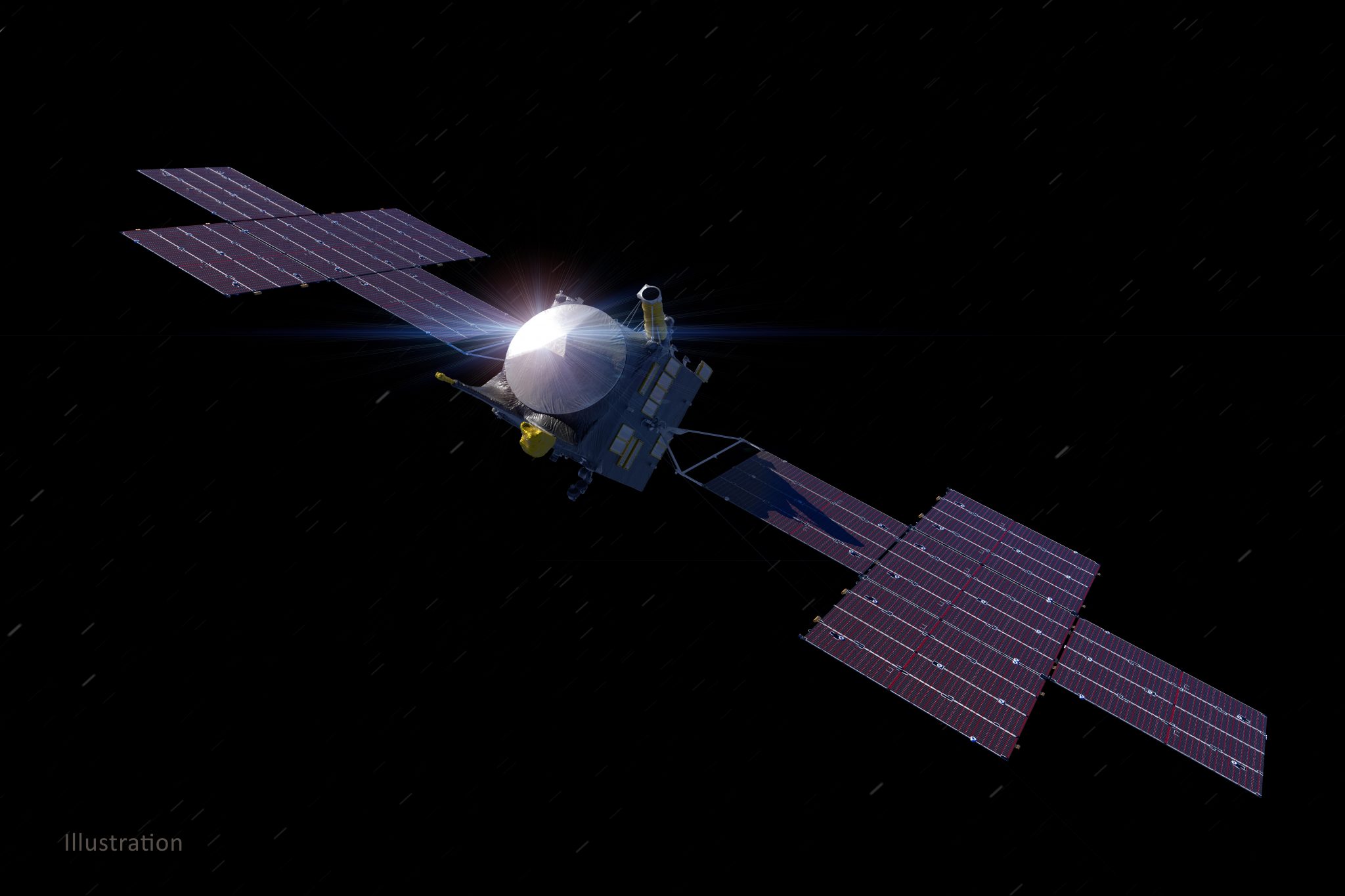
An illustration of NASA’s Psyche spacecraft and its vast solar arrays. Credit: NASA/JPL-Caltech/ASU | + Expand image

At left, xenon plasma emits a blue glow from an electric Hall thruster identical to those that will propel NASA's Psyche spacecraft to the main asteroid belt. On the right is a similar non-operating thruster. Credit: NASA/JPL-Caltech | + View image and details
The spacecraft will rely on the launch vehicle’s large chemical rocket engines to blast off the launchpad and escape Earth’s gravity, but once in space, the Psyche spacecraft will travel using solar-electric propulsion. Solar-electric propulsion uses electricity from the solar arrays to power the spacecraft’s journey to asteroid Psyche. For fuel, Psyche will carry tanks full of xenon, the same neutral gas used in car headlights and plasma TVs. The spacecraft’s four thrusters – only one of which will be on at any time – will use electromagnetic fields to accelerate and expel charged atoms, or ions, of that xenon. As those ions are expelled, they will create thrust that gently propels Psyche through space, emitting blue beams of ionized xenon. The thrust will be so gentle that it will exert about the same amount of pressure you’d feel holding three quarters in your hand, but it’s enough to accelerate Psyche through deep space. You can read more about ion propulsion in this Teachable Moment.
The spacecraft, which will travel 2.2 billion miles (3.6 billion kilometers) over nearly 6 years to reach its destination, will also use the gravity of Mars to increase its speed and to set its trajectory, or path, to intersect with asteroid Psyche’s orbit around the Sun. It will do this by entering and leaving the gravitational field of Mars, stealing just a little bit of kinetic energy from Mars’ orbital motion and adding it to its own. This slingshot move will save propellant, time, and expense by providing a trajectory change and speed boost without using any of the spacecraft’s onboard fuel.
Upon arrival at Psyche, the spacecraft will spend 26 months making observations and collecting data as it orbits the asteroid at different altitudes. Unlike many objects in the solar system that rotate like a spinning top, the asteroid Psyche rotates on its side, like a wheel. Mission planning teams had to take this unique characteristic into account in planning the spacecraft's orbits. The different orbits will provide scientists with ideal lighting for the spacecraft's cameras and they will enable the mission to observe the asteroid using different scientific instruments onboard.
The spacecraft will map and study Psyche using a multispectral imager, a gamma-ray and neutron spectrometer, a magnetometer, and a radio instrument (for gravity measurement). During its cruise to the asteroid, the spacecraft will also test a new laser communication technology called Deep Space Optical Communication, which encodes data in photons at near-infrared wavelengths instead of radio waves. Using light instead of radio allows the spacecraft to send more data back and forth at a faster rate.
Follow Along
Psyche is scheduled to launch no sooner than October 5, 2023 from Kennedy Space Center in Florida. Tune in to watch the launch on NASA TV.
Visit the mission website to follow along as data are returned and explore the latest news, images, and updates about this mysterious world.
Teach It
The Psyche mission is a great opportunity to engage students with hands-on learning opportunities. Explore these lessons and resources to get students excited about the STEM involved in the mission
Resources for Teachers
-
 Collection
CollectionPsyche Lessons for Educators
Explore a collection of standards-aligned lessons related to NASA's Psyche mission.
-
 Collection
CollectionAsteroids Lessons for Educators
Explore a collection of standards-aligned lessons all about asteroids and craters.
-
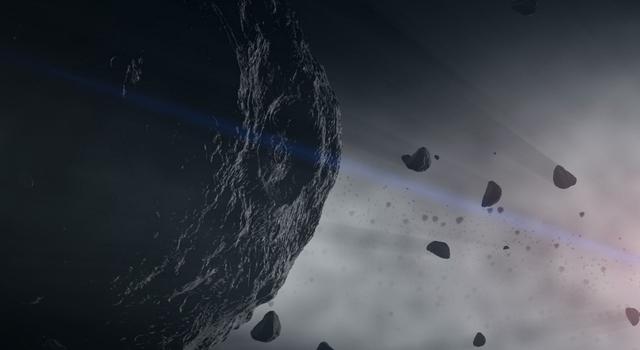 Article
ArticleTeachable Moments: How NASA Studies and Tracks Asteroids Near and Far
Studying the chemical and physical properties, as well as the location and motion of asteroids, is vital to helping us understand how the sun, planets and other solar system bodies came to be. This article explores how NASA studies and tracks asteroids.
-
 Expert Talk
Expert TalkTeaching Space With NASA: Tracking Asteroids
In this educational talk, NASA experts will discuss how we track and study comets and asteroids. Plus, we'll answer your questions!
-

Activities for Students
-

Psyche Activities for Students
Explore projects, videos, slideshows, and games for students all about asteroids.
-
 Collection
CollectionAsteroids Activities for Students
Explore projects, videos, slideshows, and games for students all about asteroids.
Explore More
Resources for Kids
Check out these related resources for kids from NASA Space Place:
- Article for Kids: Asteroid or Meteor: What's the Difference?
- Article for Kids: What Is an Asteroid?
- Article for Kids: Why Does the Moon Have Craters?
- Article for Kids: What Is an Impact Crater?
Websites
Articles
Images
Videos
Interactives
Printouts
- Print a 3D Model of the Psyche Spacecraft
- Create a Psyche Lego Model
- Create a Model of the Psyche Asteroid
TAGS: Teachers, Classroom, Lessons, Educators, K-12, Parents, Students, Resources, Asteroid TM, Psyche
Edu News | July 27, 2023
We Want to Hear From You
Share your feedback in this 5-minute survey to help JPL Education improve our offerings.
We're working on improving our offerings for educators, students, and families, and we want to hear from you!
This 5-minute survey will help us learn about what resources and offerings you use the most and what you'd like to see us do more of or do differently. Plus, we'd love to hear about the ways you're using JPL Education resources and any impact they've had on you.
This survey is completely anonymous, but you do have the option to share your email address if you would like to be contacted about future opportunities to provide feedback.
Related Resources
For K-12 Educators
Explore our collection of nearly 200 STEAM lessons as well as educational explainers of the latest NASA news, expert talks, teaching materials and more.
-
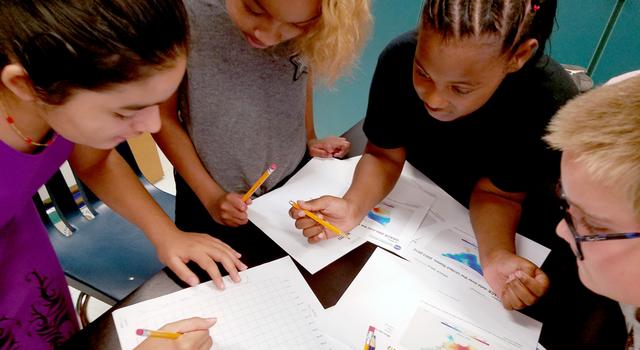 Educator Resources
Educator ResourcesLessons for Educators
Explore a collection of standards-aligned STEAM lessons featuring the latest NASA missions and science.
-
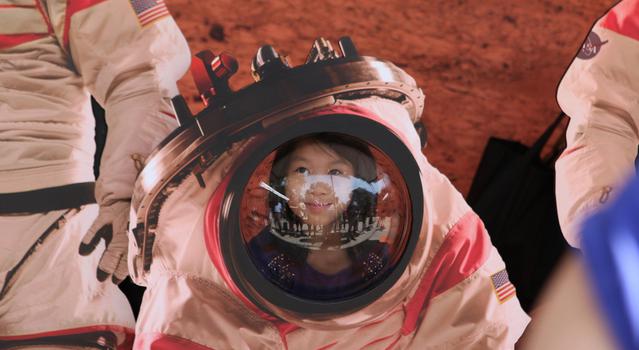 Articles
ArticlesTeachable Moments
Take a look inside the latest NASA missions and science news and find out how to get students engaged with related STEAM lessons and activities.
-
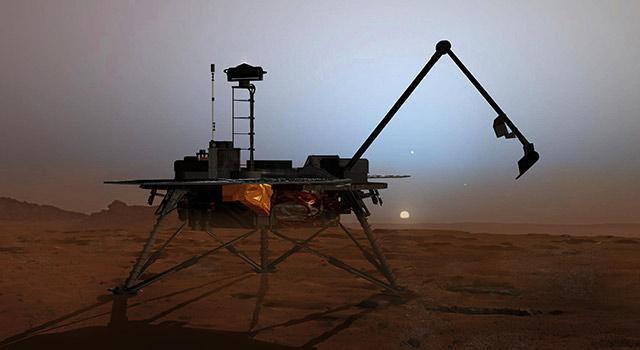 Educator Resources
Educator ResourcesNGSS Engineering in the Classroom
Learn how the Next Generation Science Standards in engineering are used at JPL and get activities and tips for bringing them into the classroom.
-
 Expert Talks
Expert TalksTeaching Space With NASA
Hear from experts and education specialists about the latest missions and science happening at NASA and get your questions answered.
-
 Showcase
ShowcaseNASA Answers: When Am I Ever Going to Use This?
We asked JPL scientists and engineers to share what STEM concepts they learned in school that they still use in their job today.
-
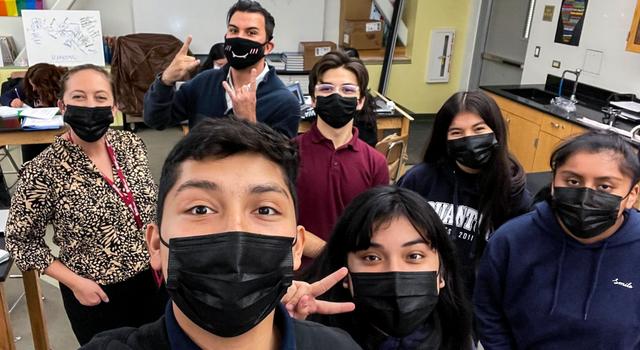 Articles
ArticlesTeacher Feature
Meet real teachers and find out how they are using STEM education resources from JPL to get creative ideas for your classroom.
-
 Educator Resources
Educator ResourcesEducator Resource Center
The NASA-JPL Educator Resource Center provides free math and science teaching materials, training workshops and hands-on demonstrations to both formal and informal educators.
-
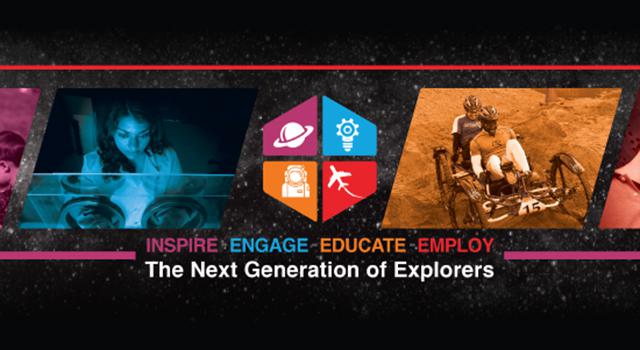 Educator Resources
Educator ResourcesNASA STEM Engagement
Engage students in STEM with resources, activities, and programs from NASA.
For K-12 Students
Get students exploring space and science on their own with hands-on projects, video tutorials, expert talks, and career guidance.
-
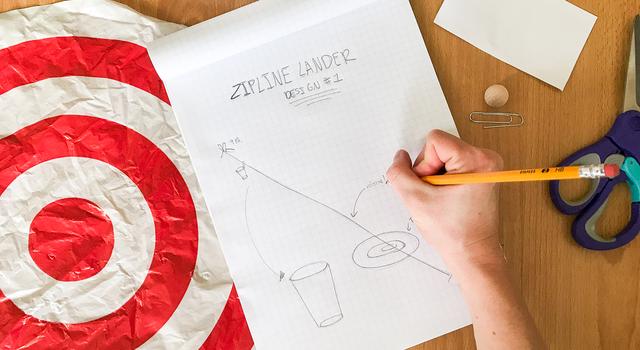 Student Resources
Student ResourcesActivities for Students
Explore Earth and space with these hands-on projects, slideshows, videos, and more for K-12 students.
-
 Student Resources
Student ResourcesLearning Space With NASA
Explore space and science activities you can do with NASA at home. Find video tutorials, DIY projects, slideshows, games and more!
-
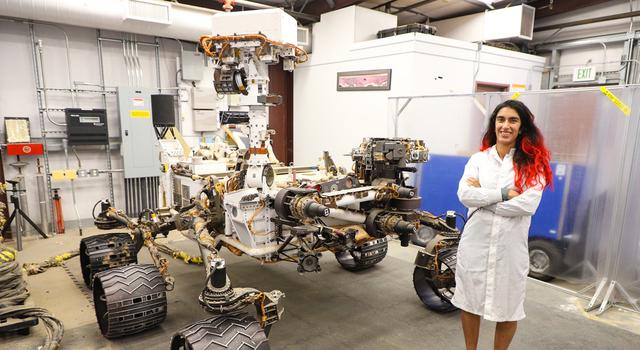 Articles
ArticlesCareer Guidance
Get advice from scientists, engineers and educators about what it takes to work in STEM and how to get a foot in the door.
-
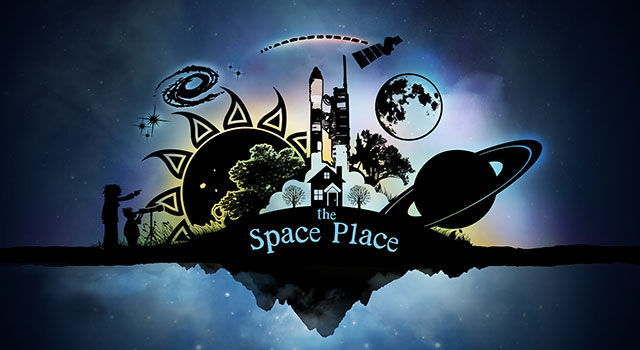 Activities for Kids
Activities for KidsNASA Space Place
Explore articles, games, and activities about space and space exploration for elementary-school-age kids.
-
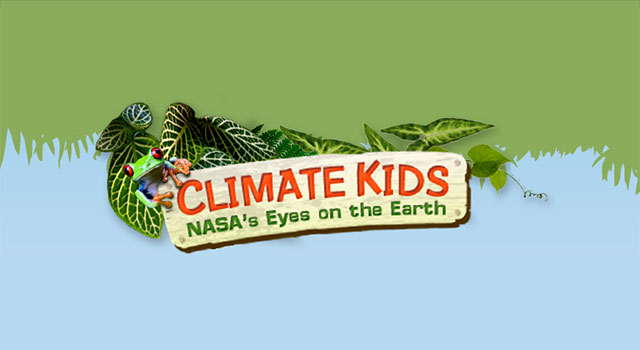 Activities for Kids
Activities for KidsNASA Climate Kids
Articles, games, and resources about Earth and our changing planet for elementary-school-age students.
For College Students
Learn about internships and fellowships at JPL and NASA, plus meet current interns, and get tips on how to make your resume stand out.
-
 Opportunities
OpportunitiesJPL Internships and Fellowships
Discover exciting internships and research opportunities at the leading center for robotic exploration of the solar system.
-
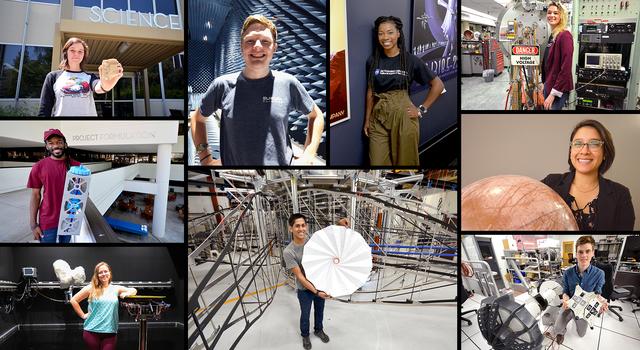 Article
ArticleHow to Get an Internship at JPL
Here's everything you need to know about the world of JPL internships, the skills that will help you stand out, and how to get on the right trajectory even before college.
-
 Articles
ArticlesMeet JPL Interns
These interns are pushing the boundaries of space exploration and science at the leading center for robotic exploration of the solar system.
-
 Opportunities
OpportunitiesJPL Jobs: Opportunities for Students
Start here to learn more about internship, fellowship, and postdoc opportunities at JPL and how to apply.
-
 Opportunities
OpportunitiesNASA Internships
Learn about internship opportunities at NASA centers across the U.S., and apply today!
-
 Articles
ArticlesNASA Intern Stories
Meet NASA interns and learn about their trajectories to the world of space exploration.
Engage With Us
From student challenges to virtual tours, expert talks, and beyond, there are numerous ways to join the conversation with us.
-
 Student Challenge
Student ChallengeMission to Mars Student Challenge
Get K-12 students exploring Mars with NASA scientists, engineers, and the Perseverance rover as they learn all about STEM and design their very own mission to the Red Planet!
-
 Events
EventsJPL Education Events
Explore educational events, workshops and competitions hosted by NASA-JPL online and in Pasadena, California.
-
 Interactive
InteractiveJPL Virtual Tour
From visiting mission control to seeing where space robots are built, this interactive tour lets online users explore the historic space facility from anywhere in the world.
-
 Expert Talks
Expert TalksJPL Lecture Series
This free monthly lecture series at JPL in Pasadena, California – and also available via webcast – features scientists and engineers discussing NASA missions and robotics.
-
 Competitions
CompetitionsStudent Team Competitions
Each year JPL encourages the academic growth and development of local high school students by sponsoring challenging academic competitions in the areas of math, science, and engineering.
-
 Student Challenge
Student ChallengeArtemis Student Challenges
This series of challenges tasks young innovators in middle school, high school, undergraduate and graduate programs to build foundational knowledge on topics and technologies critical to the success of future missions to the Moon and beyond.
Explore More
- Newsletter: JPL Education Updates
- Interactive: NASA Eyes
- Articles: People of NASA
- Events: Request a JPL Speaker
TAGS: K-12 Education, Informal Education, Resources
Teachable Moments | July 24, 2023
Exploring the Mystery of Our Expanding Universe
Learn about a new mission seeking to understand some of the greatest mysteries of our universe, and explore hands-on teaching resources that bring it all down to Earth.
Scientists may soon uncover new insights about some of the most mysterious phenomena in our universe with the help of the newly launched Euclid mission. Built and managed by the European Space Agency, Euclid will use a suite of instruments developed, in part, by NASA's Jet Propulsion Laboratory to explore the curious nature of dark energy and dark matter along with their role in the expansion and acceleration of our universe.
Read on to learn how the Euclid mission will probe these cosmological mysteries. Then, find out how to use demonstrations and models to help learners grasp these big ideas.
Why It’s Important
No greater question in our universe promotes wonder in scientists and non-scientists alike than that of the origin of our universe. The Euclid mission will allow scientists to study the nearly imperceptible cosmic components that may hold exciting answers to this question.
Edwin Hubble's observations of the expanding universe in the 1920s marked the beginnings of what's now known as the big-bang theory. We've since made monumental strides in determining when and how the big bang would have taken place by looking at what's known as cosmic background radiation using instruments such as COBE and WMAP in 1989 and 2001, respectively. However, there's one piece of Hubble's discovery that still has scientists stumped: our universe is not only expanding, but as scientists discovered in 1998, that expansion is also accelerating.
This side by side comparison shows a constant rate of expansion of the universe, represented by the expanding sphere on the left, and an accelerating rate of expansion of the universe, represented by the expanding sphere on the right. Each dot on the spheres represents a galaxy and shows how galaxies move apart from each other faster in the universe that has an accelerating rate of expansion. | Watch on YouTube
How can this be? It makes intuitive sense that, regardless of the immense force of the big bang that launched all matter across the known universe 13.8 billion years ago, that matter would eventually come to a rest and possibly even start to collapse. Instead, it's as if we've dropped a glass onto the ground and discovered that the shards are flying away from us faster and faster into perpetuity.

An illustrated timeline of the universe. Credit: WMAP | + Expand image
Scientists believe that answers may lie in two yet-to-be-understood factors of our universe: dark matter and dark energy. Dark matter is unlike the known matter we experience here on Earth, such as what's found on the periodic table. We can't actually see dark matter; we can only infer its presence. It has mass and therefore gravity, making it an attractive force capable of pulling things together. Amazingly, dark matter makes up roughly 27% of the known universe compared with the much more modest 5% of "normal matter" that we experience day to day. However, dark matter is extremely dilute throughout the universe with concentrations of 105 particles per cubic meter.
This animated pie chart shows rounded values for the three known components of the universe: visible matter (5%), dark matter (27%), and dark energy (68%). Credit: NASA's Goddard Space Flight Center | › Full video and caption
In opposition to the attractive force of dark matter, we have dark energy. Dark energy is a repulsive force and makes up roughly 68% of energy in the known universe. Scientists believe that the existence of dark energy and the amount of repulsion it displays compared with dark matter is what's causing our universe to not only expand, but also to expand faster and faster.
Dr. Jennifer Wiseman, a senior project scientist with the Hubble Space Telescope mission, explains how the mission has been helping scientists learn more about dark energy. Credit: NASA Goddard | Watch on YouTube
But to truly understand this mysterious force and how it interacts with both dark matter and normal matter, scientists will have to map barely detectable distortions of light traversing the universe, carefully measuring how that light changes over time and distance in every direction. As JPL Astrophysicist Jason Rhodes explains, “Dark energy has such a subtle effect that we need to survey billions of galaxies to adequately map it.”
And that's where Euclid comes in.
How It Works
The European Space Agency and NASA each contributed to the development of the Euclid mission, which launched from Cape Canaveral Space Force Station in Florida on July 1. The spacecraft consists of a 1.2-meter (48-inch) space telescope and two science instruments: an optical camera and a near-infrared camera that also serves as a spectrometer. These instruments will provide a treasure trove of data for scientists of numerous disciplines, ranging from exoplanet hunters to cosmologists.

Light waves get stretched as the universe expands similar to how this ink mark stretches out as the elastic is pulled. Get students modeling and exploring this effect with this standards-aligned math lesson. Credit: NASA/JPL-Caltech | + Expand image

This graphic illustrates how cosmological redshift works and how it offers information about the universe’s evolution. Credit: NASA, ESA, Leah Hustak (STScI) | › Full image and caption
As Gisella de Rosa at the Space Telescope Science Institute explains, “The ancillary science topics we will be able to study with Euclid range from the evolution of the objects we see in the sky today to detecting populations of galaxies and creating catalogs for astronomers. The data will serve the entire space community.”
The cameras aboard Euclid will operate at 530-920 nanometers (optical light) and at 920-2020 nanometers (near infrared) with each boasting more than 576 million and 65 million pixels, respectively. These cameras are capable of measuring the subtle changes to the light collected from celestial objects and can determine the distances to billions of galaxies across a survey of 15,000 square degrees – one-third of the entire sky.
Meanwhile, Euclid's spectrometer will collect even more detailed measurements of the distance to tens of millions of galaxies by looking at redshift. Redshift describes how wavelengths of light change ever so slightly as objects move away from us. It is a critical phenomenon for measuring the speed at which our universe is expanding. Similar to the way sound waves change as a result of the Doppler effect, wavelengths of light are compressed to shorter wavelengths (bluer) as something approaches you and extended to longer wavelengths (redder) as it moves away from you. As determined by a Nobel Prize winning team of astronomers, our universe isn’t just red-shifting over time, distant objects are becoming redder faster.
Euclid will measure these incredibly minuscule changes in wavelength for objects near and far, providing an accurate measurement of how the light has changed as a factor of time and distance and giving us a rate of acceleration of the universe. Furthermore, Euclid will be able to map the relative densities of dark matter and normal matter as they interact with dark energy, creating unevenly distributed pockets of more attractive forces. This will allow scientists to identify minute differences in where the universe is expanding by looking at the way that light is altered or "lensed."
The multi-dimensional maps created by Euclid – which will include depth and time in addition to the height and width of the sky – will inform a complementary mission already in development by NASA, the Nancy Grace Roman Space Telescope. Launching in 2026, this space telescope will look back in time with even greater detail, targeting areas of interest provided by Euclid. The telescope will use instruments with higher sensitivity and spatial resolution to peer deeper into redshifted and faint galaxies, building on the work of Euclid to look farther into the accelerating universe. As Caltech’s Gordon Squires describes it: “We’re trying to understand 90% of our entire universe. Both of these telescopes will provide essential data that will help us start to uncover these colossal mysteries.”
Teach It
The abstract concepts of the scope and origin of our universe and the unimaginable scale of cosmology can be difficult to communicate to learners. However, simple models and simulations can help make these topics more tangible. See below to find out how, plus explore more resources about our expanding universe.Resources
-
 Educator Guide
Educator GuideModel the Expanding Universe
Students learn about the role of dark energy and dark matter in the expansion of the universe, then make a model using balloons.
Subject Science
Grades 6-12
Time 30-60 mins
-
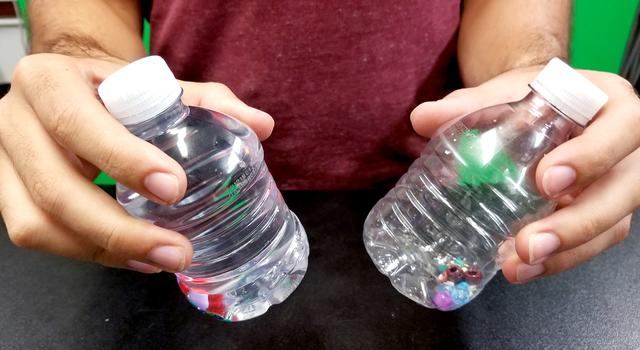 Educator Guide
Educator GuideHow Do We See Dark Matter?
Students will make observations of two containers and identify differences in content, justify their claims and make comparisons to dark matter observations.
Subject Science
Grades 6-12
Time Less than 30 mins
-
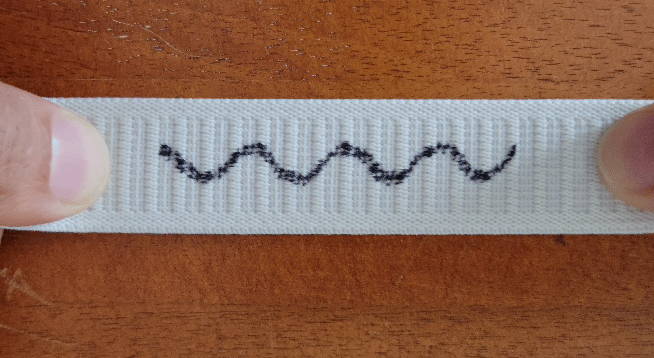 Educator Guide
Educator GuideMath of the Expanding Universe
Students will learn about the expanding universe and the redshift of lightwaves, then perform their own calculations with a distant supernova.
Subject Science
Grades 9-12
Time 30-60 mins
-
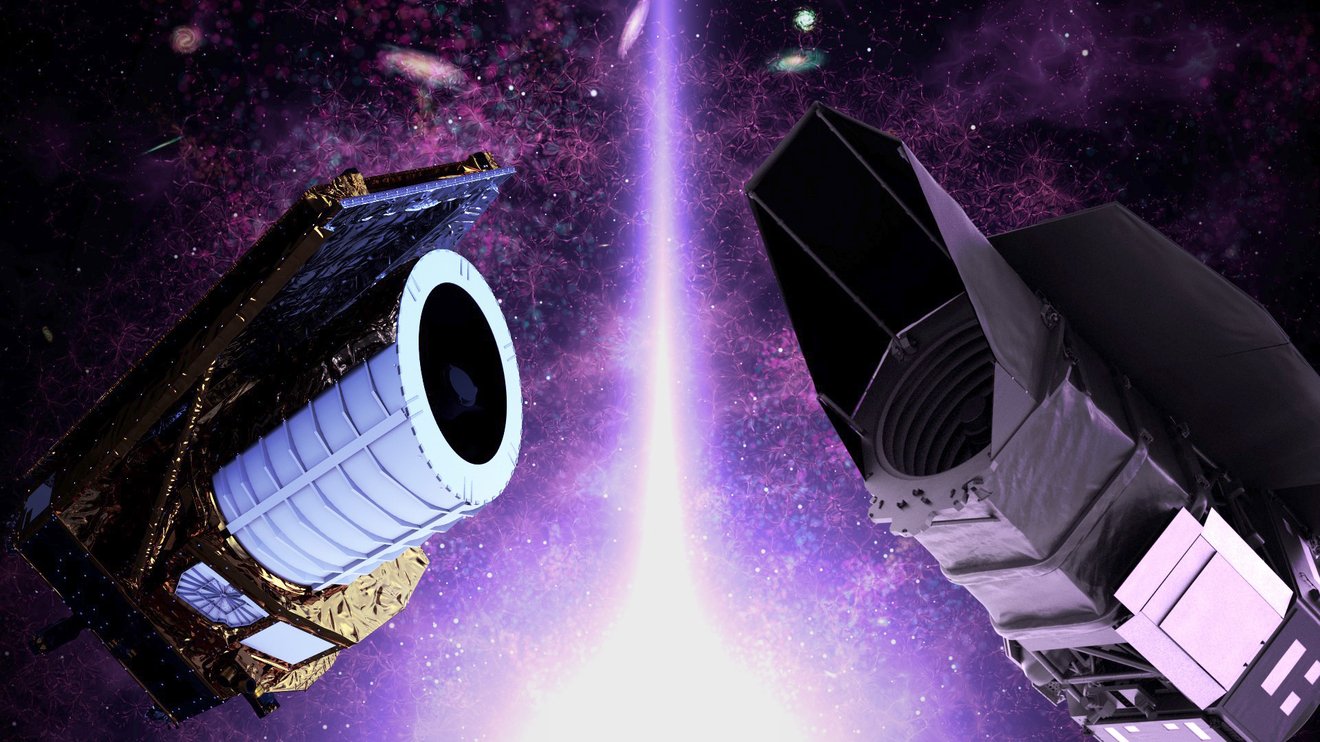 Collection
CollectionViewSpace: Dark Energy Videos
Use this collection of short videos to introduce learners to the concept of dark energy.
- Collection
ViewSpace: Dark Matter Videos
Use this collection of short videos to introduce learners to the concept of dark matter.
-
 Science Briefing
Science BriefingHubble Constant Discrepancies: Implications for Our Expanding Universe
Hear experts discuss how the rate of the universe is measured in different cosmological epochs and what the differences in those measures can tell us.
-
 Game
GameRoman Space Observer
How many astrophysical objects can you catch?
Explore More
- Article for Kids: What Is a Supernova?
- Article for Kids: What Is Dark Matter?
- Article: What Is Dark Energy?
- Article: Gravitational Lensing - Shining a Light on Dark Matter
- Facts & Figures: Euclid Mission - NASA
- Facts & Figures: Nancy Grace Roman Space Telescope
NASA's Universe of Learning materials are based upon work supported by NASA under award number NNX16AC65A to the Space Telescope Science Institute, working in partnership with Caltech/IPAC, Center for Astrophysics | Harvard & Smithsonian, and the Jet Propulsion Laboratory.
TAGS: K-12 Education, Teaching, Teachers, Educators, Resources, Universe, Dark Matter, Dark Energy, Euclid, Nancy Grace Roman Space Telescope, Universe of Learning
Teachable Moments | March 9, 2023
10 Years of NASA's Pi Day Challenge
Learn how pi is used by NASA and how many of its infinite digits have been calculated, then explore the science and engineering that makes the Pi Day Challenge possible.
Update: March 15, 2023 – The answers are here! Visit the NASA Pi Day Challenge page to view the illustrated answer keys for each problem.
This year marks the 10th installment of the NASA Pi Day Challenge. Celebrated on March 14, Pi Day is the annual holiday that pays tribute to the mathematical constant pi – the number that results from dividing any circle's circumference by its diameter.
Every year, Pi Day gives us a reason to celebrate the mathematical wonder that helps NASA explore the universe and enjoy our favorite sweet and savory pies. Students can join in the fun once again by using pi to explore Earth and space themselves in the NASA Pi Day Challenge.
Read on to learn more about the science behind this year's challenge and find out how students can put their math mettle to the test to solve real problems faced by NASA scientists and engineers as we explore Earth, Mars, asteroids, and beyond!

Visit the Pi in the Sky 10 lesson page to explore classroom resources and downloads for the 2023 NASA Pi Day Challenge. Image credit: NASA/JPL-Caltech | + Expand image
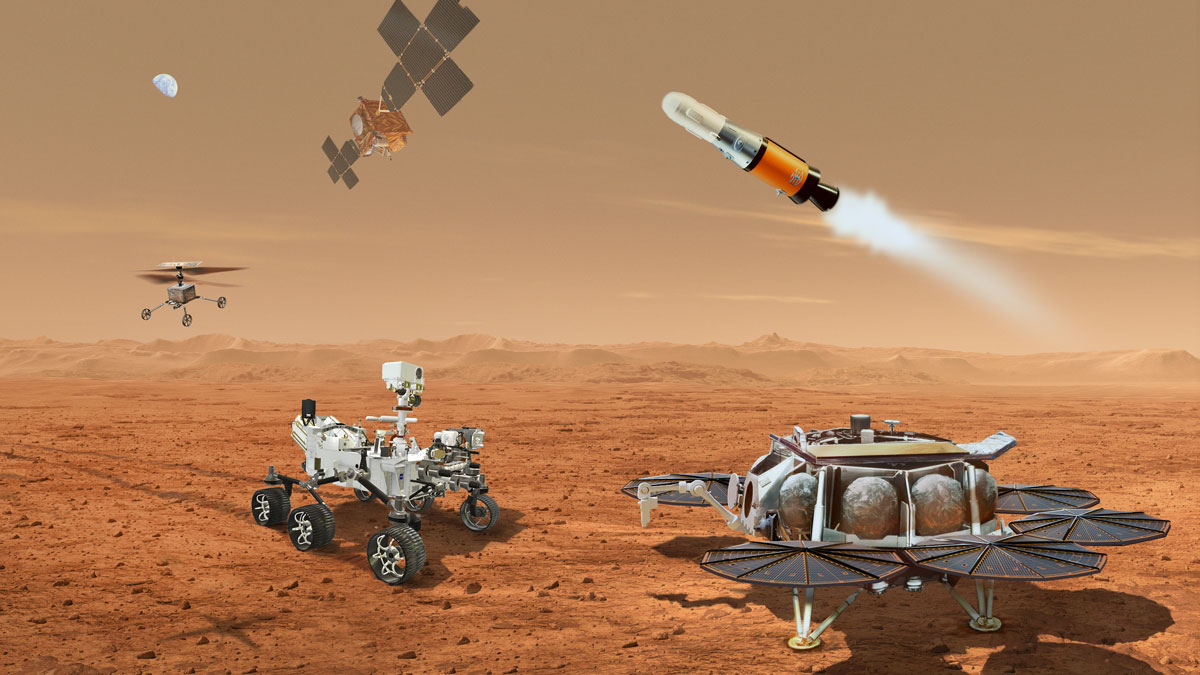
This illustration shows a concept for multiple robots that would team up to ferry to Earth samples of rocks and soil being collected from the Martian surface by NASA's Mars Perseverance rover. Image credit: NASA/JPL-Caltech | › Full image and caption
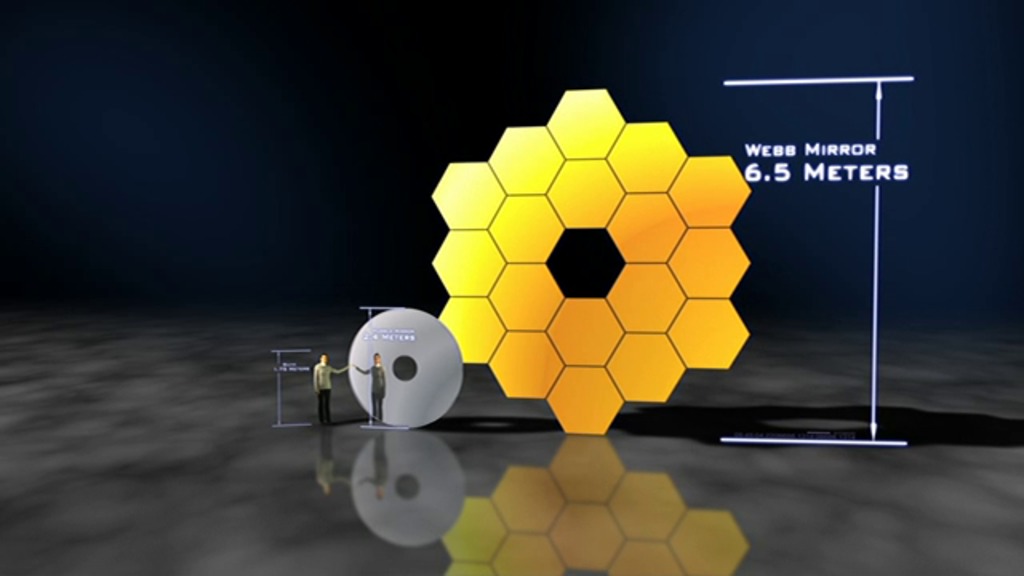
Image from animation comparing the relative sizes of James Webb's primary mirror to Hubble's primary mirror. Credit: NASA/Goddard Space Flight Center . | › Full animation

This illustration depicts the metal-rich asteroid Psyche, which is located in the main asteroid belt between Mars and Jupiter. Credits: NASA/JPL-Caltech/ASU | + Full image and caption
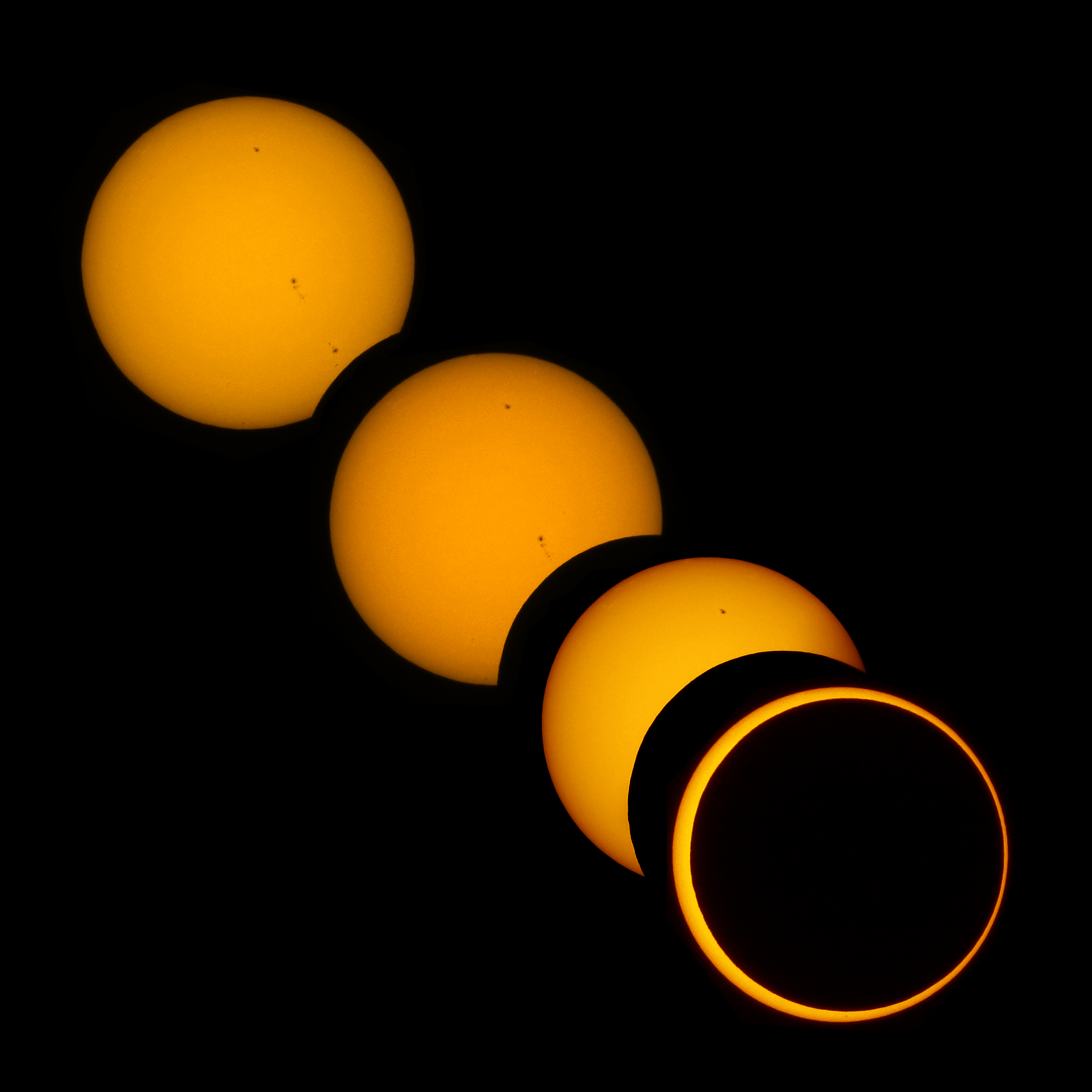
This image sequence shows an annular solar eclipse from May 2012. The bottom right frame illustrates the distinctive ring, or "annulus," of such eclipses. A similar eclipse will be visible from the South Pacific on May 10, 2013. Credits: Brocken Inaglory, CC BY-SA 3.0, via Wikimedia Commons | + Expand image
How It Works
Dividing any circle’s circumference by its diameter gives you an answer of pi, which is usually rounded to 3.14. Because pi is an irrational number, its decimal representation goes on forever and never repeats. In 2022, mathematician Simon Plouffe discovered the formula to calculate any single digit of pi. In the same year, teams around the world used cloud computing technology to calculate pi to 100 trillion digits. But you might be surprised to learn that for space exploration, NASA uses far fewer digits of pi.
Here at NASA, we use pi to measure the area of telescope mirrors, determine the composition of asteroids, and calculate the volume of rock samples. But pi isn’t just used for exploring the cosmos. Since pi can be used to find the area or circumference of round objects and the volume or surface area of shapes like cylinders, cones, and spheres, it is useful in all sorts of ways. Transportation teams use pi when determining the size of new subway tunnels. Electricians can use pi when calculating the current or voltage passing through circuits. And you might even use pi to figure out how much fencing is needed around a circular school garden bed.
In the United States, March 14 can be written as 3.14, which is why that date was chosen for celebrating all things pi. In 2009, the U.S. House of Representatives passed a resolution officially designating March 14 as Pi Day and encouraging teachers and students to celebrate the day with activities that teach students about pi. And that's precisely what the NASA Pi Day Challenge is all about!
The Science Behind the 2023 NASA Pi Day Challenge
This 10th installment of the NASA Pi Day Challenge includes four noodle-nudgers that get students using pi to calculate the amount of rock sampled by the Perseverance Mars rover, the light-collecting power of the James Webb Space Telescope, the composition of asteroid (16) Psyche, and the type of solar eclipse we can expect in October.
Read on to learn more about the science and engineering behind each problem or click the link below to jump right into the challenge.
› Take the NASA Pi Day Challenge
› Educators, get the lesson here!
Tubular Tally
NASA’s Mars rover, Perseverance, was designed to collect rock samples that will eventually be brought to Earth by a future mission. Sending objects from Mars to Earth is very difficult and something we've never done before. To keep the rock cores pristine on the journey to Earth, the rover hermetically seals them inside a specially designed sample tube. Once the samples are brought to Earth, scientists will be able to study them more closely with equipment that is too large to make the trip to Mars. In Tubular Tally, students use pi to determine the volume of a rock sample collected in a single tube.
Rad Reflection
When NASA launched the Hubble Space Telescope in 1990, scientists hoped that the telescope, with its large mirror and sensitivity to ultraviolet, visible, and near-infrared light, would unlock secrets of the universe from an orbit high above the atmosphere. Indeed, their hope became reality. Hubble’s discoveries, which are made possible in part by its mirror, rewrote astronomy textbooks. In 2022, the next great observatory, the James Webb Space Telescope, began exploring the infrared universe with an even larger mirror from a location beyond the orbit of the Moon. In Rad Reflection, students use pi to gain a new understanding of our ability to peer deep into the cosmos by comparing the area of Hubble’s primary mirror with the one on Webb.
Metal Math
Orbiting the Sun between Mars and Jupiter, the asteroid (16) Psyche is of particular interest to scientists because its surface may be metallic. Earth and other terrestrial planets have metal cores, but they are buried deep inside the planets, so they are difficult to study. By sending a spacecraft to study Psyche up close, scientists hope to learn more about terrestrial planet cores and our solar system’s history. That's where NASA's Psyche comes in. The mission will use specialized tools to study Psyche's composition from orbit. Determining how much metal exists on the asteroid is one of the key objectives of the mission. In Metal Math, students will do their own investigation of the asteroid's makeup, using pi to calculate the approximate density of Psyche and compare that to the density of known terrestrial materials.
Eclipsing Enigma
On Oct. 14, 2023, a solar eclipse will be visible across North and South America, as the Moon passes between Earth and the Sun, blocking the Sun's light from our perspective. Because Earth’s orbit around the Sun and the Moon’s orbit around Earth are not perfect circles, the distances between them change throughout their orbits. Depending on those distances, the Sun's disk area might be fully or only partially blocked during a solar eclipse. In Eclipsing Enigma, students get a sneak peek at what to expect in October by using pi to determine how much of the Sun’s disk will be eclipsed by the Moon and whether to expect a total or annular eclipse.
Teach It
Celebrate Pi Day by getting students thinking like NASA scientists and engineers to solve real-world problems in the NASA Pi Day Challenge. In addition to solving this year’s challenge, you can also dig into the more than 30 puzzlers from previous challenges available in our Pi Day collection. Completing the problem set and reading about other ways NASA uses pi is a great way for students to see the importance of the M in STEM.
Pi Day Resources
-

Pi in the Sky Lessons
Here's everything you need to bring the NASA Pi Day Challenge into the classroom.
Grades 4-12
Time Varies
-

NASA Pi Day Challenge
The entire NASA Pi Day Challenge collection can be found in one, handy slideshow for students.
Grades 4-12
Time Varies
-

How Many Decimals of Pi Do We Really Need?
While you may have memorized more than 70,000 digits of pi, world record holders, a JPL engineer explains why you really only need a tiny fraction of that for most calculations.
-

18 Ways NASA Uses Pi
Whether it's sending spacecraft to other planets, driving rovers on Mars, finding out what planets are made of or how deep alien oceans are, pi takes us far at NASA. Find out how pi helps us explore space.
-
10 Ways to Celebrate Pi Day With NASA on March 14
Find out what makes pi so special, how it’s used to explore space, and how you can join the celebration with resources from NASA.
-

Infographic: Planet Pi
This poster shows some of the ways NASA scientists and engineers use the mathematical constant pi (3.14) and includes common pi formulas.
-

Downloads
Can't get enough pi? Download this year's NASA Pi Day Challenge graphics, including mobile phone and desktop backgrounds:
-

National Council of Teachers of Mathematics: Notice and Wonder
Creative brainstorming through noticing and wondering encourages student participation, engagement, and students' understanding of the NASA Pi Day Challenge.
Subject Mathematics
-
Pi Day: What's Going 'Round
Tell us what you're up to this Pi Day and share your stories and photos on our showcase page.
Plus, join the conversation using the hashtag #NASAPiDayChallenge on Facebook, Twitter, and Instagram.
Related Lessons for Educators
-

Robotic Arm Challenge
In this challenge, students will create a model robotic arm to move items from one location to another. They will engage in the engineering design process to design, build and operate the arm.
Grades K-8
Time 30 min to 1 hour
-

NASA's Mission to Mars Student Challenge
Take part in the exploration of Mars and bring students along for the ride with NASA's Perseverance rover.
Grades K-12
Time Varies
-

Moon Phases
Students learn about the phases of the moon by acting them out.
Grades 1-6
Time 30 min to 1 hour
-

Modeling the Earth-Moon System
Students learn about scale models and distance by creating a classroom-size Earth-Moon system.
Grades 6-8
Time 30 min to 1 hour
-

Math of the Expanding Universe
Students will learn about the expanding universe and the redshift of lightwaves, then perform their own calculations with a distant supernova.
Grades 9-12
Time 30 min to 1 hour
-
The Expanded Universe: Playing with Time Activity Guide
In this activity, participants use balloons to model the expansion of the universe and observe how expansion affects wavelengths of light and distance between galaxies
-

James Webb Space Telescope STEM Toolkit
Find a collection of resources, activities, videos, and more for your students to learn about NASA’s newest space observatory.
-

Modeling an Asteroid
Lead a discussion about asteroids and their physical properties, then have students mold their own asteroids out of clay.
Grades 3-5
Time 30 min to 1 hour
-

Math Rocks: A Lesson in Asteroid Dynamics
Students use math to investigate a real-life asteroid impact.
Grades 8-12
Time 30 min to 1 hour
Related Activities for Students
-
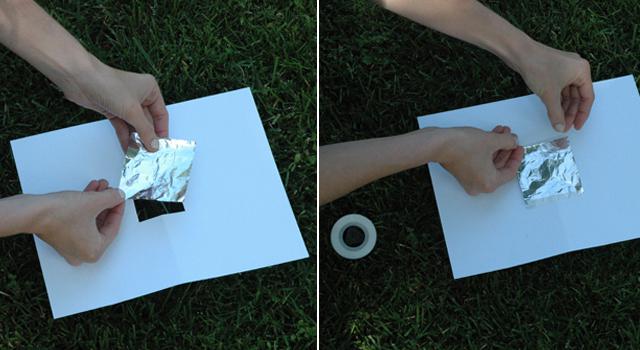
How to Make a Pinhole Camera
Learn how to make your very own pinhole camera to safely see a solar eclipse in action!
Type Project
Subject Engineering
-
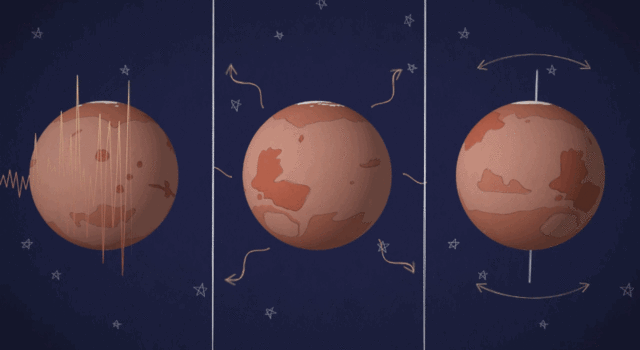
Collection: Exploring Mars
Make a cardboard rover, design a Mars exploration video game and explore more STEM projects, slideshows and videos for students.
Type Project
Subject Science
-

What's That Space Rock?
Find out how to tell the difference between asteroids, comets, meteors, meteorites and other bodies in our solar system.
Type Slideshow
Subject Science
-
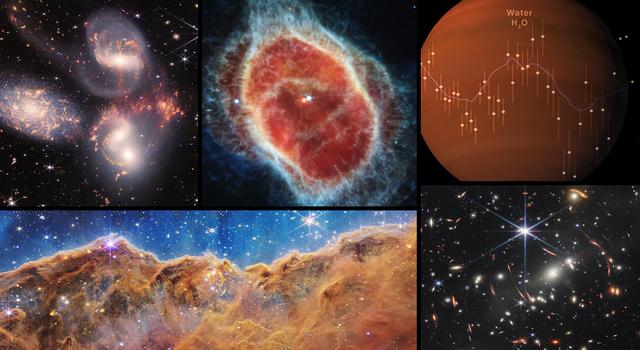
10 Things We Can Learn from Webb's First Images
Take a closer look at how images from NASA's most powerful space telescope yet are helping to answer some of astronomers' most burning questions.
Type Slideshow
Subject Science
Recursos en español
Facts and Figures
Websites
- Webb Space Telescope
- Mars Exploration
- Perseverance Mars Rover
- Mars Sample Return
- Psyche Mission
- MIRI Instrument
- 2023 Eclipse
Articles
Videos
Interactives
TAGS: Pi Day, Pi, Math, NASA Pi Day Challenge, sun, moon, earth, eclipse, asteroid, psyche, sample return, mars, perseverance, jwst, webb, hubble, telescope, miri
Teachable Moments | December 8, 2022
NASA Mission Takes a Deep Dive Into Earth's Surface Water
Explore how and why the SWOT mission will take stock of Earth's water budget, what it could mean for assessing climate change, and how to bring it all to students.
Update: Dec. 15, 2022 – NASA, the French space agency, and SpaceX are now targeting 3:46 a.m. PST (6:46 a.m. EST) on Friday, Dec.16, for the launch of the Surface Water and Ocean Topography (SWOT) satellite. Visit NASA's SWOT launch blog for the latest updates.
NASA is launching an Earth-orbiting mission that will map the planet’s surface water resources better than ever before. Scheduled to launch on Dec. 16 from Vandenberg Space Force Base in California, the Surface Water and Ocean Topography, or SWOT mission is the latest international collaboration designed to monitor and report on our home planet. By providing us with a highly detailed 3D view of rivers, lakes, and oceans, SWOT promises to improve our understanding of Earth’s water cycle and the role oceans play in climate change, as well as help us better respond to drought and flooding.
Read on to find out why we're hoping to learn more about Earth's surface water, get to know the science behind SWOT's unique design, and follow along with STEM teaching and learning resources.
Why It's Important
Observing Earth from space provides scientists with a global view that is important for understanding the whole climate system. In the case of SWOT, we will be able to monitor Earth’s surface water with unprecedented detail and accuracy. SWOT will provide scientists with measurements of water volume change and movement that will inform our understanding of fresh water availability, flood hazards, and the mechanisms of climate change.
Scientists and engineers provide an overview of the SWOT mission. Credit: NASA/JPL-Caltech | Watch on YouTube
Water Flow
Scientists use a variety of methods to track Earth’s water. These include stream and lake gauges and even measurements from space such as sea surface altimetry and gravitational measurements of aquifer volumes. Monitoring of river flow and lake volume is important because it can tell us how much freshwater is readily available and at what locations. River flow monitoring can also help us make inferences about the downstream environmental impact. But monitoring Earth’s surface water in great detail with enough frequency to track water movement has proven challenging. Until now, most monitoring of river flow and lake levels has relied on water-flow and water-level gauges placed across Earth, which requires that they be accessible and maintained. Not all streams and lakes have gauges and previous space-based altimetry and gravitational measurements, though useful for large bodies of water, have not been able to adequately track the constant movement of water through smaller rivers or lakes.
Here's why understanding Earth’s "water budget" is an important part of understanding our planet and planning for future water needs.
SWOT will be able to capture these measurements across the globe in 3D every 21 days. The mission will monitor how much water is flowing through hundreds of thousands of rivers wider than 330 feet (100 meters) and keep a close watch on the levels of more than a million lakes larger than 15 acres (6 hectares). Data from the mission will be used to create detailed maps of rivers, lakes, and reservoirs that will enable accurate monitoring to provide a view of freshwater resources that is not reliant on physical access. Meanwhile, SWOT’s volumetric measurements of rivers, lakes, and reservoirs will help hydrologists better track drought and flooding impacts in near-real-time.
Coastal Sea Level Rise
SWOT will measure our oceans with unprecedented accuracy, revealing details of ocean features as small as 9 miles (15 kilometers) across. SWOT will also monitor sea levels and tides. Though we have excellent global sea level data, we do not have detailed sea level measurements near coastlines. Coastal sea levels vary across the globe as a result of ocean currents, weather patterns, land changes, and other factors. Sea levels are rising faster than ever, and higher sea levels also mean that hurricane storm surges will reach farther inland than ever before, causing substantially more damage than the same category of hurricanes in the past. SWOT will be able to monitor coastal sea level variations and fill gaps in the observations we currently have from other sources.
What is sea level rise and what does it mean for our planet? | › View Transcript
Ocean Heat Sinks
Further contributing to our understanding of the role Earth’s oceans play in climate change, SWOT will explore how the ocean absorbs atmospheric heat and carbon, moderating global temperatures and climate change. Scientists understand ocean circulation on a large scale and know that ocean currents are driven by temperature and salinity differences. However, scientists do not currently have a good understanding of fine-scale ocean currents, where most of the ocean's motion-related energy is stored and lost. Circulation at these fine scales is thought to be responsible for transporting half of the heat and carbon from the upper ocean to deeper layers. Such downward ocean currents have helped to mitigate the decades-long rise in global air temperatures by absorbing and storing heat and carbon away from the atmosphere. Knowing more about this process is critical for understanding the mechanisms of global climate change.
JPL scientist Josh Willis uses a water balloon to show how Earth's oceans are absorbing most of the heat being trapped on our warming world. | › Related lesson
These fine-scale ocean currents also transport nutrients to marine life and circulate pollutants such as crude oil and debris. Understanding nutrient transport helps oceanographers assess ocean health and the productivity of fisheries. And tracking pollutants aids in natural hazard assessment, prediction, and response.
How It Works
A joint effort between NASA and the French space agency – with contributions from the Canadian and UK space agencies – SWOT will continue NASA’s decades-long record of monitoring sea surface height across the globe. But this mission will add a level of detail never before achieved.
SWOT will measure more than 90% of Earth’s surface water, scanning the planet between 78°N latitude and 78°S latitude within 1 centimeter of accuracy and retracing the same path every 21 days. Achieving this level of accuracy from a spacecraft height of 554 miles (891 kilometers) requires that the boom using radar to measure water elevation remain stable within 2 microns – or about 3% of the thickness of a human hair.
This visualization shows ocean surface currents around the world during the period from June 2005 through December 2007. With its new, high resolution wide-swath measurements, SWOT will be able to observe eddies and current features at greater resolution than previously possible. Credit: NASA Scientific Visualization Studio | Watch on YouTube
Prior to SWOT, spacecraft have used conventional nadir, or straight-down, altimetry to measure sea surface height. Conventional nadir altimetry sends a series of radar or laser pulses down to the surface and measures the time it takes for each signal to return to the spacecraft, thus revealing distances to surface features. To acquire more detailed information on surface water, SWOT will use an innovative instrument called the Ka-band Radar Interferometer, or KaRIn, to measure water height with exceptional accuracy. Ka-band is a portion of the microwave part of the electromagnetic spectrum. SWOT uses microwaves because they can penetrate clouds to return data about water surfaces.

SWOT will track Earth's surface water in incredible detail using an innovative instrument called the Ka-band Radar Interferometer, or KaRIn. Image credit: NASA/JPL-Caltech | + Expand image
The KaRIn instrument uses the principles of synthetic aperture radar combined with interferometry to measure sea surface height. A radar signal is emitted from the end of the 10-meter-wide boom on the spacecraft. The reflected signal is then received by antennas on both ends of the boom, capturing data from two 30-mile (50-kilometer) wide swaths on either side of the spacecraft. The received signals will be slightly out of sync, or phase, from one another because they will travel different distances to return to the receivers on either end of the boom. Knowing the phase difference, the distance between the antennas, and the radar wavelength allows us to calculate the distance to the surface.

Radar signals bounced off the water’s surface will be received by antennas on both ends of SWOT's 10-meter-wide boom. The received signals will be slightly out of phase because they will travel different distances as they return to the receivers. Scientists use this phase difference and the radar wavelength to calculate the distance to the surface. Image credit: NASA/JPL-Caltech | + Expand image
The observations acquired by the two antennas can be combined into what is known as an interferogram. An interferogram is a pattern of wave interference that can reveal more detail beyond the 1-centimeter resolution captured by the radar. To explain how it works, we'll recall a couple of concepts from high school physics. When out-of-phase waves from the two antennas are combined, constructive and destructive interference patterns result in some wave crests being higher and some wave troughs being lower than those of the original waves. The patterns that result from the combination of the waves reveal more detail with resolution better than the 1-centimeter wavelength of the original Ka-band radar waves because the interference occurs over a portion of a wavelength. An interferogram can be coupled with elevation data to reveal a 3D representation of the water’s surface.

The KaRIn instrument illuminates two parallel tracks of approximately 50 kilometres on either side of a nadir track from a traditional altimeter. The signals are received by two antennas 10 metres apart and are then processed to yield interferometry measurements. Image credit: NASA/JPL-Caltech | + Expand image
This highly accurate 3D view of Earth’s surface water is what makes SWOT so unique and will enable scientists to more closely monitor the dynamics of the water cycle. In addition to observing ocean currents and eddies that will inform our understanding of the ocean’s role in climate change, SWOT's use of interferometry will allow scientists to track volumetric changes in lakes and quantify river flooding, tasks that cannot yet be done on a wide scale in any other way.
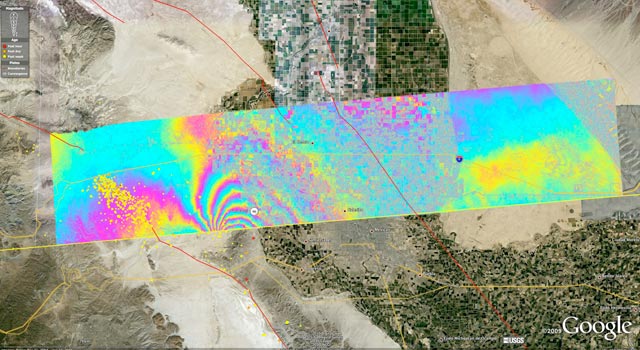
This interferogram was captured by the air-based UAVSAR instrument of the magnitude 7.2 Baja California earthquake of April 4, 2010. The interferogram is overlaid atop a Google Earth image of the region. Image credit: NASA/JPL/USGS/Google | › Learn more
Follow Along
SWOT is scheduled to launch no earlier than Dec. 16, 2022, on a SpaceX Falcon 9 rocket from Vandenberg Space Force Base in California. Tune in to watch the launch on NASA TV.
After launch, the spacecraft will spend 6-months in a calibration and validation phase, during which it will make a full orbit of Earth every day at an altitude of 553 miles (857 kilometers). Upon completion of this phase, SWOT will increase its altitude to 554 miles (891 kilometers) and assume a 21-day repeat orbit for the remainder of its mission.
Visit the mission website to follow along as data are returned and explore the latest news, images, and updates as SWOT provides a new view on one of our planet's most important resources.
Teach It
The SWOT mission is the perfect opportunity to engage students in studying Earth’s water budget and water cycle. Explore these lessons and resources to get students excited about the STEM involved in studying Earth’s water and climate change from space.
Educator Resources
-
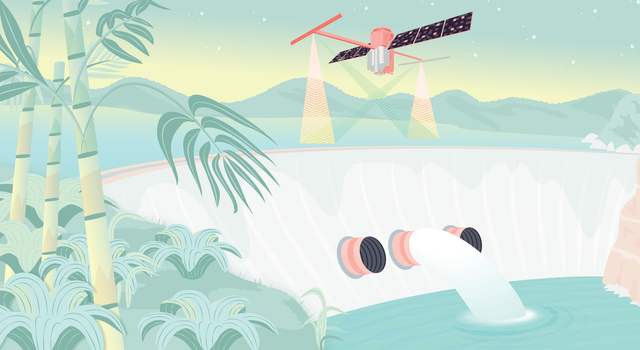 Collection
CollectionSWOT Mission Lessons for Educators
Explore the science and engineering behind the SWOT mission with this collection of standards-aligned lessons all about water.
-
 Collection
CollectionClimate Change Lessons for Educators
Explore a collection of standards-aligned STEM lessons for students that get them investigating climate change along with NASA.
-
 Collection
CollectionTeachable Moments in Climate Change
Explore this collection of Teachable Moments articles to get a primer on the latest NASA Earth science missions, plus find related education resources you can deploy right away!
-
 Expert Talk
Expert TalkTeaching Space With NASA – Monitoring Earth from Space
In this educational talk, NASA experts discuss how we build spacecraft to study climate, then answer audience questions.
Student Activities
-
 Collection
CollectionSWOT Mission Activities for Students
Explore projects, videos, slideshows, and games for students all about the water cycle and sea level rise.
-
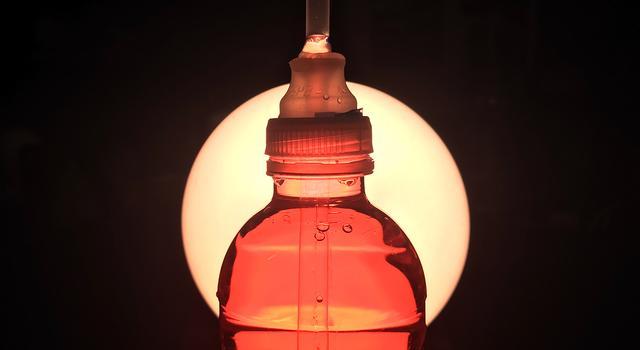 Collection
CollectionClimate Change Activities for Students
Learn about climate change and its impacts with these projects, videos, and slideshows for students.
-
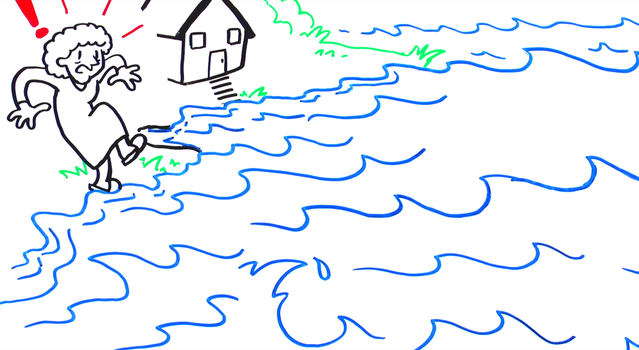 Collection
CollectionEarth Minute Video Series
This series of animated white-board videos for students of all ages explains key concepts about Earth science, missions, and climate change.
Explore More
Activities for Kids
- Download: SWOT Launch Bingo
- Video: How Much Water is on Earth?
- Game: Go With the Flow – An Ocean Currents Game
Websites
- SWOT Mission Website
- NASA Climate Change
- NASA Earth Observatory
- NASA Climate Kids
- NASA Sea Level Change
- NASA Cambio Climático en Español
Facts & Figures
Videos
Interactives
Image Gallery
Articles
- Climate articles from NASA
- Ask NASA Climate
- NASA People - Earth
- Water Mission to Gauge Alaskan Rivers on Front Lines of Climate Change
Podcast
TAGS: K-12 Education, Teachers, Educators, Earth Science, Earth, Climate Change, Climate, Satellites, Teachable Moments, Climate TM
Edu News | October 24, 2022
How Many Decimals of Pi Do We Really Need?
While world record holders may have memorized more than 70,000 digits of pi, a JPL engineer explains why you really only need a tiny fraction of that for most calculations – even at NASA.
Update: October 24, 2022 – This article, originally written in 2016, has been updated to reflect the latest values for NASA’s Voyager 1 spacecraft, which continues to venture farther into interstellar space. The author, Marc Rayman, has ventured on too, from the chief engineer for NASA’s Dawn mission, which concluded successfully in 2018, to the chief engineer for mission operations and science at NASA’s Jet Propulsion Laboratory.

This graphic shows more than 500 of the infinite number of decimals in pi. Image credit: NASA/JPL-Caltech | + Expand image
We received this question from a fan on Facebook who wondered how many decimals of the never-ending mathematical constant pi (π) NASA-JPL scientists and engineers use when making calculations:
“Does JPL only use 3.14 for its pi calculations? Or do you use more decimals, like say [360 or even more]?”
Here’s JPL’s Chief Engineer for Mission Operations and Science, Marc Rayman, with the answer:
Thank you for your question! This isn't the first time I've heard a question like this. In fact, it was posed many years ago by a sixth-grade science and space enthusiast who was later fortunate enough to earn a doctorate in physics and become involved in space exploration. His name was Marc Rayman.
To start, let me answer your question directly. For JPL's highest accuracy calculations, which are for interplanetary navigation, we use 3.141592653589793. Let's look at this a little more closely to understand why we don't use more decimal places. I think we can even see that there are no physically realistic calculations scientists ever perform for which it is necessary to include nearly as many decimal points as you asked about. Consider these examples:
- The most distant spacecraft from Earth is Voyager 1. As of this writing, it’s about 14.7 billion miles (23.6 billion kilometers) away. Let’s be generous and call that 15 billion miles (24 billion kilometers). Now say we have a circle with a radius of exactly that size, 30 billion miles (48 billion kilometers) in diameter, and we want to calculate the circumference, which is pi times the radius times 2. Using pi rounded to the 15th decimal, as I gave above, that comes out to a little more than 94 billion miles (more than 150 billion kilometers). We don't need to be concerned here with exactly what the value is (you can multiply it out if you like) but rather what the error in the value is by not using more digits of pi. In other words, by cutting pi off at the 15th decimal point, we would calculate a circumference for that circle that is very slightly off. It turns out that our calculated circumference of the 30-billion-mile (48-billion-kilometer) diameter circle would be wrong by less than half an inch (about one centimeter). Think about that. We have a circle more than 94 billion miles (more than 150 billion kilometers) around, and our calculation of that distance would be off by no more than the width of your little finger.

Put your pi math skills to the test with this problem from NASA's Pi Day Challenge. Can you use pi to determine what fraction of a signal from Voyager 1 reaches Earth? Image credit: NASA/JPL-Caltech | + Expand image | › View lesson page
- We can bring this closer to home by looking at our planet, Earth. It is more than 7,900 miles (12,700 kilometers) in diameter at the equator. The circumference is roughly 24,900 miles (40,100 kilometers). That's how far you would travel if you circumnavigated the globe – and didn't worry about hills, valleys, and obstacles like buildings, ocean waves, etc. How far off would your odometer be if you used the limited version of pi above? The discrepancy would be the size of a molecule. There are many different kinds of molecules, of course, so they span a wide range of sizes, but I hope this gives you an idea. Another way to view this is that your error by not using more digits of pi would be more than 30,000 times thinner than a hair!

Image credit: NASA | + Expand image
- Let's go to the largest size there is: the known universe. The radius of the universe is about 46 billion light years. Now let me ask (and answer!) a different question: How many digits of pi would we need to calculate the circumference of a circle with a radius of 46 billion light years to an accuracy equal to the diameter of a hydrogen atom, the simplest atom? It turns out that 37 decimal places (38 digits, including the number 3 to the left of the decimal point) would be quite sufficient. Think about how fantastically vast the universe is. It’s certainly far beyond what you can see with your eyes even on the darkest, most beautiful night of sparkling stars. It’s yet farther beyond the extraordinary vision of the James Webb Space Telescope. And the vastness of the universe is truly far, far, far beyond what we can even conceive. Now think about how incredibly tiny a single atom is. Isn’t it amazing that we wouldn’t need to use many digits of pi at all to cover that entire unbelievable range?

If you were to hold a single grain of sand at arm's length, you could cover the entire area of space taken up by this image, which was captured by the James Webb Space Telescope and contains thousands of galaxies. The oldest-known galaxy identified in the image is 13.1 billion years old. Image credit: NASA, ESA, CSA, STScI | + Expand image | › More about the image | Text description (PDF)
Pi is an intriguing number with interesting mathematical properties. It’s fun to think about its truly endless sequence of digits, and it may be surprising how often it appears in the equations scientists and engineers use. But there are no questions – prosaic or esoteric – in humankind’s noble efforts to explore or comprehend the marvels of the cosmos, from the unimaginably smallest scales to the inconceivably largest, that could require very many of those digits.
Hear more from Marc in his inspiring TEDx talk, “If It Isn’t Impossible, It Isn’t Worth Trying” and in his Dawn Journal, where he wrote frequent updates about the Dawn mission’s extraordinary extraterrestrial expedition to the protoplanet Vesta and dwarf planet Ceres.
Explore More
Educator Resources
-

NASA Pi Day Challenge
This collection of illustrated math problems gets students using pi like NASA scientists and engineers exploring Earth and space.
Grades 4-12
Time Varies
-

Pi in the Sky Lessons
Find everything you need to bring the NASA Pi Day Challenge into the classroom, including printable handouts of each illustrated math problem.
Grades 4-12
Time Varies
Articles
-

18 Ways NASA Uses Pi
Whether it's sending spacecraft to other planets, driving rovers on Mars, finding out what planets are made of or how deep alien oceans are, pi takes us far at NASA. Find out how pi helps us explore space.
-
10 Ways to Celebrate Pi Day With NASA on March 14
Find out what makes pi so special, how it’s used to explore space, and how you can join the celebration with resources from NASA.
Multimedia & Downloads
Recursos en español
TAGS: Pi, Pi Day, Dawn, Voyager, Engineering, Science, Mathematics






